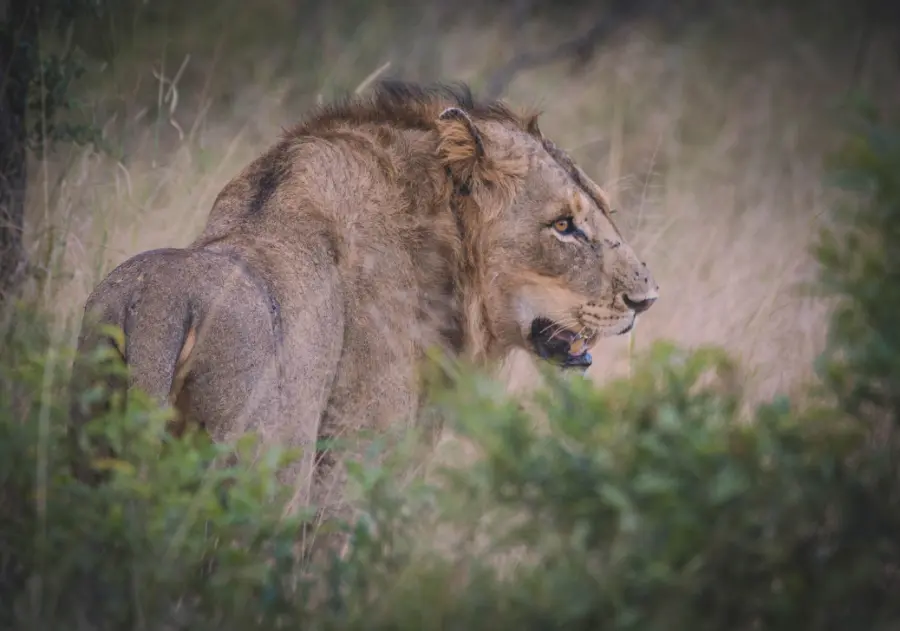
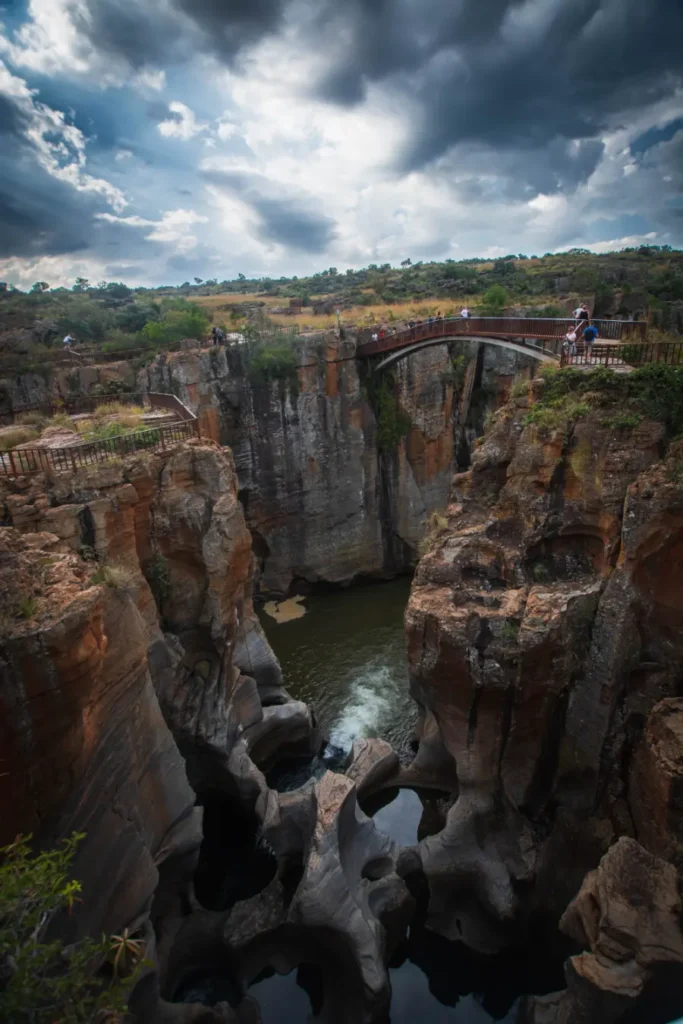

South Africa will blow your mind! In this itinerary, we’ll take you along on our self-driving journey spanning two weeks in the eastern part of the country. Planning a trip for just two weeks in this beautiful land can seem overwhelming, but don’t worry – we’ve been on both two-week and three-week trips, each with its own unique charms. Opting for a two-week adventure doesn’t mean sacrificing an incredible travel experience; in fact, you’ll find plenty of unforgettable moments awaiting you.
The specifics of your itinerary are entirely up to you, but this post is designed to help you plan for your trip. While the western part of South Africa boasts attractions like the renowned wine regions of Stellenbosch and the breathtaking city of Cape Town, if your main goal is to experience the wonders of a safari, it might be worth skipping these destinations and starting your journey in Durban – just as we did!
This marks my second visit to South Africa; the first was back in 2016. Now, in 2023, I’m exploring the country with my brother and father. After two days in Dubai (you can check out my post on the perfect weekend in Dubai here), we flew into Durban to kick off our adventure.
Summary
- Getting there & Getting around
- Day 1: Settling in Durban
- Day 2-4: Experiencing your first safaris in St. Lucia
- Day 5: Get in touch with local culture in eSwatini
- Day 6-9: Finding the Big 5 in Kruger National Park
- Day 10-11: Become awestruck by the geological beauties on the Graskop scenic drive
- Day 12-14: Relaxing in Africa’s Vegas: Sun City
- Day 15: Fly back from Johannesburg O.R. Tambo Airport
Getting there & getting around
Starting your journey for a safari oriented trip to South Africa will usually start from either King Shaka International Airport in Durban or from O.R. Tambo International Airport in Johannesburg. There’s also a small airport near Kruger (Kruger Mpumalanga International Airport) if you want to get as close to the action as fast as possible.
In this tool below you can find the cheapest flights available from your location!
After you’ve landed at Durban International Airport (or O.R. Tambo if you’re doing the trip in reverse) you can pick up your rental car. Our favourite rental agency is always going to be [Sunnycars], we’ve used this company all over the world (Costa Rica, United States, South Africa etc.) and it’s the only rental agency with no fine print to worry about. You’re always fully insured with them without extra cost, as the prices are just as competitive as other big rental agency’s.
Day 1: Durban
Whenever we travel and arrive somewhere after a long flight, I always seek out a cozy apartment or B&B to rest before continuing on. That’s why we’ve planned to stay in Durban for one night – it’s a chance to acclimate to life in South Africa and get some much-needed rest before heading further east.
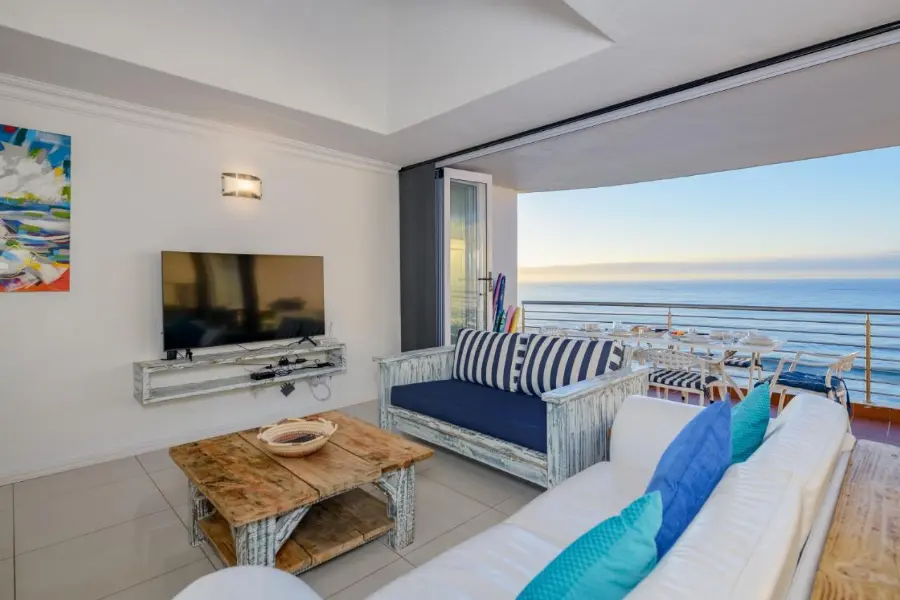
We picked up our rental car from Sunny Cars and made a short 10-minute drive to Durban Beachside. Our accommodation for the night was the delightful Chaka’s Cove, a charming beachside property that I couldn’t recommend more!
One thing to keep in mind is the prevalence of power outages in South Africa (known as load shedding). Power cuts can happen unexpectedly, as we experienced firsthand! Upon arriving at Chaka’s Cove, we found ourselves in complete darkness.
To make the most of the situation, we decided to head to a nearby restaurant called “2 On Main” for a taste of local cuisine, indulging in some Springbok Carpaccio paired with an affordable wine.
Day 2-4: St. Lucia
The drive to St. Lucia and what to see on the way
Hopefully you feel refreshed after a good night’s rest, because you’re going to take your car on the road and drive to St. Lucia – a 3 hour drive from Durban.
Although the drive is pretty scenic and a good way to get to know the South African roads, there are not that many noteworthy stops on this part of the drive.
King Shaka Memorial & King Shaka Visitor Centre
King Shaka is and was a legendary figure in South African history, and a very important person for the Zulu peoples of the southeast. The town of KwaDakuza hosts a memorial in his honour and a small museum called the King Shaka Visitor Centre. It’s on the way to Saint Lucia, so if you’re looking for some cultural enrichment, make sure to stop here!
Hluhluwe-iMfolozi National Park
You will visit this amazing national park either way, but you can choose to head directly into the park for the afternoon and drive to your accommodation after you’ve had your first thrilling ride trough the park (more on the park later)
Where to stay in St. Lucia?
We stayed in Lidiko Lodge on McKenzie street, and this was one of our favorite accommodations of the entire trip. A beautiful swimming pool with lovely rooms and the monkeys that try to steal a bite of your breakfast was the cherry on top.


What to do in St. Lucia?
St. Lucia (total population: 1.104) is a sleepy, touristy town on the coast of the Indian Ocean. It boasts a main street, McKenzie street, lined with shops, tour operators, hotels and restaurants. The town has a very quaint feel to it, and is very close to a few dynamite safari destinations
St. Lucia has to be our favorite place to stay in South Africa, and probably not for any reason you would expect. Despite its low population number, at night, the population increases by a few dozen hippopotamuses! They roam the streets looking for yummy garden plants, leftover cucumbers they find in residents’ trash or the freshly cut lawns.
This means you can’t walk from a restaurant to your hotel because hippo’s will absolutely demolish you if you get too close (they are the most dangerous large land mammal in the entire world, killing over 500 people per year). Nonetheless, if you stay in your car you will be safe, and we drove around St. Lucia’s streets every night looking for them and got lucky a couple of times.

Since you are staying here for a couple of nights, there are several things you can do. I will list them in no particular order, but since you have three days you can do them in any order you like. In almost all cases, going on safari is likely going to be the highlight of your St. Lucia stay. Before we dive into all the different ways to find wildlife in and around St. Lucia, I’ve made a list of some safari tips that I would have loved to have known on my first safari trip. These are all based on my personal experience, not only in South Africa, but trying to find wildlife all over the world.
General Car-safari tips
Car etiquette and self drive vs guided tours
- Always adhere to the speed limit. You don’t want to be that tourist that drove too fast and hit wildlife. Respect the environment.
- This should probably go without saying, but don’t leave your vehicle or litter.
- Self drives are (much) cheaper and you have more freedom than on a guided tour;
- Guided tours communicate amongst eachother, so there’s a bigger chance of seeing wildlife and the wildlife guides are trained and can tell you interesting things about the area and the animals. I would always do at least one guided tour on your safari trip.
- If you’re in your own car, almost always follow guided tour cars if you can for the reason stated above.
- If there’s a lot of cars not moving, there’s probably something interesting to see. Roll down your window (if it’s safe) and ask someone what you might see.
- Don’t be a hoarder. If there’s a leopard in a tree, don’t hog the spot – have a look, take some pictures, then continue onward to free the spot for someone else.
How to find wildlife
- Stay close to water as animals are most likely to congregate around water sources.
- Drive slowly. Choose a loop and drive really slowly there (10-15 km/h) the chances of seeing wildlife while driving slowly increases exponentially. Do you think we would have seen this chameleon (see below) if we had been going at 40 km/h?
- Get up early and stay until sunset. Animals are much more active around sunset and sunrise, especially predators. Don’t expect to see much action in the blistering afternoon sun.
- Check the bulletin boards in the main camps, sometimes locations of high profile sightings will be posted there (such as cheetahs, leopards or lions).

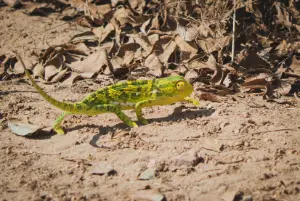

Specific for Kruger National Park: Download the LatestKruger App, with updated sightings every day. You can get push notifications if someone found a leopard in your vicinity if that’s what you like! This does take some of the surprise and wonder away, so it may not be for everyone.
Option 1: iSimangaliso Wetland Park
The closest national park to St. Lucia is iSimangaliso Wetland Park at just a 14 minute drive. The region was the first UNESCO-world heritage site of South Africa, and when you drive around the park the serenity is unmatched compared to busier parks like Kruger or Hluhluwe-iMfolozi.
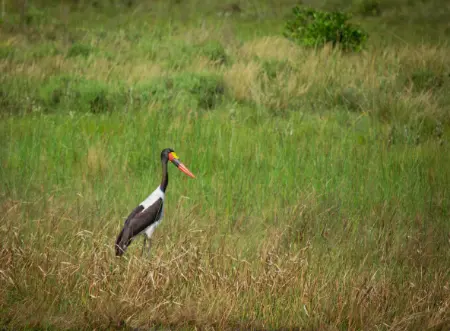


It’s a great introduction to a safari-focused trip, and while the wildlife may not be as abundant as in Kruger, the views of the Indian Ocean and the lake more than make up for it. It is especially beautiful around sunset or sunrise, and you can find all of the big 5 here, however, lion and leopard sightings are extremely rare.
We spotted hippo’s, crocodiles, baboons, rhino’s, buffalo’s and herds of elephants while driving around the park. A very nice perk to this park and absolutely unique compared to other safari-orientated parks is Cape Vidal. Visit in the morning and you’ll hit this pristine sand beach around lunchtime for a nice picnic in the sand. A welcome break from staring out your window looking for elephants and kudu’s.

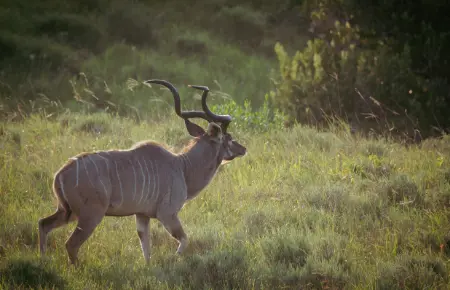
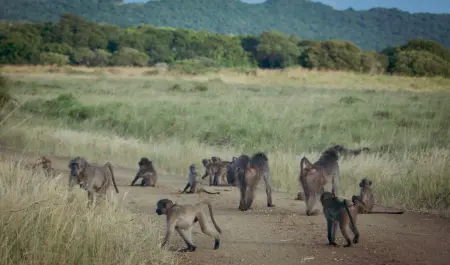
Option 2: Hluhluwe-iMfolozi National Park
While technically two different parks, Hluhluwe and iMfolozi are basically one big park, separated by the R618 road splitting it in half. You will probably enter through Nyalazi gate on the eastern side, and it’s a ~60 minute drive from St. Lucia – this means that you have to leave early to make sure you arrive early enough for the morning animal rush hour. It also means that if you stay until dusk, it can mean you have to be okay with driving back in the dark (depending on the season).
The last stretch of road into St. Lucia can be quite dark with many people walking back into town, and it can feel sketchy driving there if it’s too dark. If this is something that bothers you, you can also opt for 2 nights in St. Lucia and spending 1 night closer to the park.

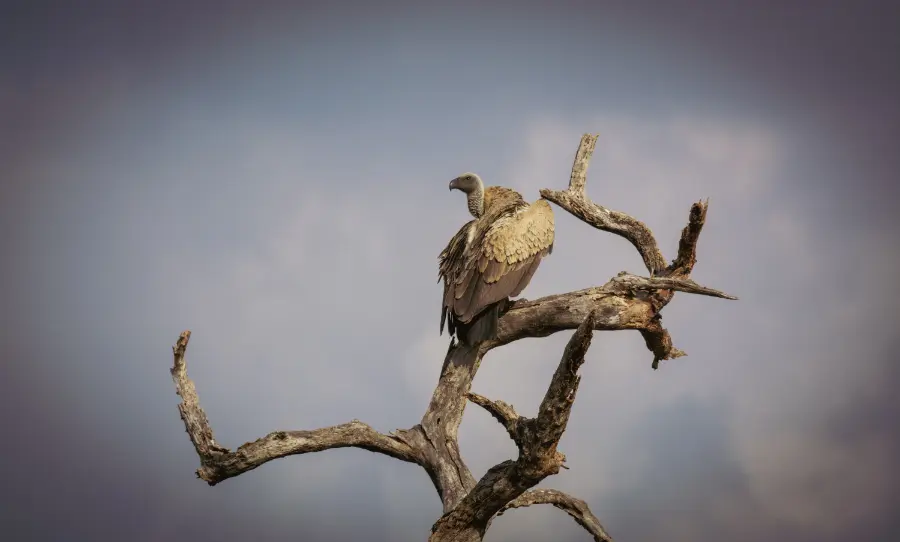

Hluhluwe-iMfolozi is a revered and huge wildlife park. You could be here for a week and still discover new roads to explore, it’s amazing in so many ways! The park is great for wildlife, you can find the entire big 5 here – we found all but the leopard in Hluhluwe-iMfolozi – but it is most known for its rhinoceros population, both white and black. You are all but guaranteed to see rhino’s while driving around the park!
We drove a few of the park loops over the course of two days and saw rhinoceri, hippo’s, a lot of impala’s, kudu, zebra’s, giraffes, countless elephants, buffalo herds, crocodiles, a chameleon, ospreys, different eagles and much more. I cannot overstate how much wildlife you will find in Hluhluwe-iMfolozi, especially when you visit during the early morning and the late afternoon.
When I was little I always wanted to work with animals (I never did) so driving around Hluhluwe-iMfolozi was like a dream come true for little me. You really start to grasp the biodiversity of South-Africa when you drive around this park.
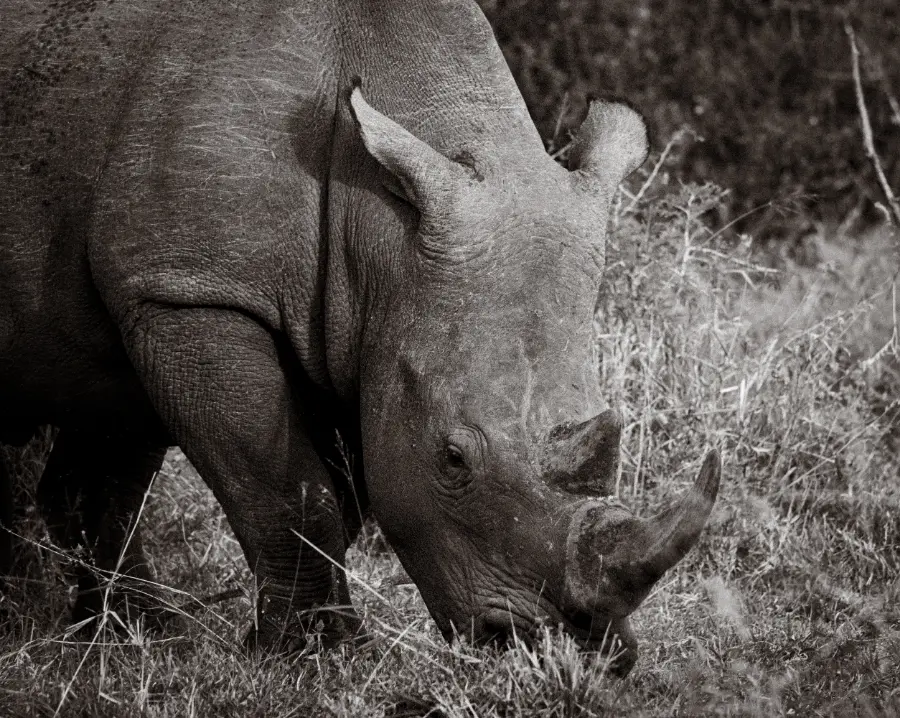
I could tell you exactly where we saw which animals, but unfortunately they probably aren’t in the same place! Keeping that disclaimer in mind, I will unveil my two favorite loops, where we had the most luck with wildlife sightings. On the Seme and Maqanda loops we saw a lot of rhino’s bathing in the mud, a beautiful vulture perching on top of a dead tree, a bachelor crocodile pretending we weren’t there and a baby elephant brazenly charging our car from a safe distance. We got lucky on these two loops on both visits to the park, but it may have just been a coincidence!
Check the general car safari tips for more tips you can apply to your Hluhluwe-iMfolozi visit.


Option 3: Lake St. Lucia
Something else you can do is take a boat tour of Lake St. Lucia! We booked a St Lucia Lake Estuary Sunset Boat Tour (https://www.tripadvisor.nl/AttractionProductReview-g312636-d11460426-St_Lucia_Estuary_Boat_Cruise-St_Lucia_KwaZulu_Natal.html). This is a nice way to enjoy a different kind of safari, the guide picks you up at your hotel, drive to the jetty and he will tell you everything about the ecosystem of Lake St Lucia, the estuary and the ocean.
The sunsets are beautiful and you will most likely see hippo’s, crocodiles and different kinds of birds of prey and waterfowl. There’s also some snacks, fruits and rooibos-tea aboard for you to consume.


St. Lucia Itinerary
With so much to do in and around St. Lucia, it may be daunting to choose when to do what. I can’t choose for you, but I can share our itinerary of our time in St. Lucia:
- Day 2: As you depart from Durban, take the long way to St. Lucia and drive through Hluhluwe-iMfolozi National Park. Enter via the Cengeni gate in the southwest, drive a couple of loops and leave through the Nyalazi gate in the east. You should arrive at your accommodation in the late afternoon ready to check in. Jump in the pool, have some dinner and then drive around the village looking for hippo’s.
- Day 3: Catch the sunset in iSimangaliso National Park and drive the main loop to Cape Vidal and have a picnic. After the beach visit, take the smaller loops back to the entrance and have a relaxing afternoon at the pool. Grab another bite in St. Lucia, and if you’re like me and can’t get enough of the safari, go looking for hippo’s again!
- Day 4: Get up early and drive to Hluhluwe-iMfolozi Nyalazi gate and be there at sunset. Either do a self drive and take some smaller loops, or organize a guided tour. You can easily spend all day, while taking a break at Mthwazi Lodge for some lunch with a view. Leave Hluhluwe-iMfolozi before or after sunset (depending on if you’re comfortable driving back in the dark, and depending on the season), go out for dinner in St. Lucia one last time (and go look for some more hippo’s if you’re not sick of it yet).
- Day 5: Check out of your hotel. Either carry on with the itinerary and drive towards eSwatini for your next destination, or alternatively, you can do another morning loop of Hluhluwe-iMfolozi if you feel you can’t leave it behind just yet.
Day 5: eSwatini
The drive to eSwatini and what to see on the way
The drive into eSwatini is okay – certainly not the most scenic drive on your road trip. You could do what we did – and that is get up early once more, and drive a couple more loops in iSimangaliso Wetland Park for the chance of some golden hour-showered wildlife.
Get out of the park around noon and make your way to a nice break location: the Zamimpilo Craft Market located 50 minutes north of St. Lucia. You can pick up some hand crafted souvenirs and some fresh pineapple for the road. Afterwards, stop for lunch at Ngweni Railroad Brewery & Cafe a short 20 minute drive further north. When you’re done with the lunch, continue your drive north to Lobamba, which will take another 4 hours
Zamimpilo Craft Market
Locally produced, very affordable and you will feel like you are at the heart of South Africa. Amazing place to spend 30 minutes, and grab some fresh fruits before you head on the long road trip to Lobamba.
Ngweni Railroad Brewery & Cafe
Nice, affordable stop for lunch. They have many different African beers and a lot of variation for lunch. Great portions, great prices.
Where to stay in eSwatini?
There’s many lovely places to stay in eSwatini, and most accommodations will be centered near the capital city of Mbabane.
We stayed in the Mantenga Cultural Village, which is also one of the main tourist attractions in the country.
What to do in eSwatini?
It’s time to take a break from the safari and cross the border into eSwatini, formerly known as Swaziland, changed back to their pre-colonial name. This country, sandwiched between South Africa and Mozambique, is a tiny nation with a lot to offer. Resorts, wildlife, hiking – eSwatini has plenty.
On our trip, we only stayed in eSwatini for a day, as we wanted to get to Kruger as fast as we could. However, I would recommend staying for 2 or maybe 3 days, in hindsight. There is a lot you can do in eSwatini, and it’s a nice break from the intense safari days.
The border crossing is usually pretty easy, however it can be quite busy in the high season. Visa requirements for most western countries are very lenient, but make sure to check here
One thing you need to keep in mind on this border crossing is the permit from your rental agency. When crossing the border (or any border for that matter), you need special permission from your car rental agency to do so. This is usually no issue, but you need to remember this during your booking process, otherwise you can’t bring your rental car across the border.
Mantenga Cultural Village
As we only stayed in eSwatini for one night, we didn’t get the chance to really explore what the country has to offer. Because we had already spent a few days driving around different safari-parks, we opted for a more cultural experience during our stay in eSwatini.
We stayed in the Mantenga Cultural Village, which is an open-air museum created to familiarize tourists with the traditional Swazi culture. You can choose a tour around the grounds, which is what we did, and you’ll be guided around the area by a guide that will tell you all about Swazi culture in the 19th century, and how many traditions hailing from that period are still in practice today.

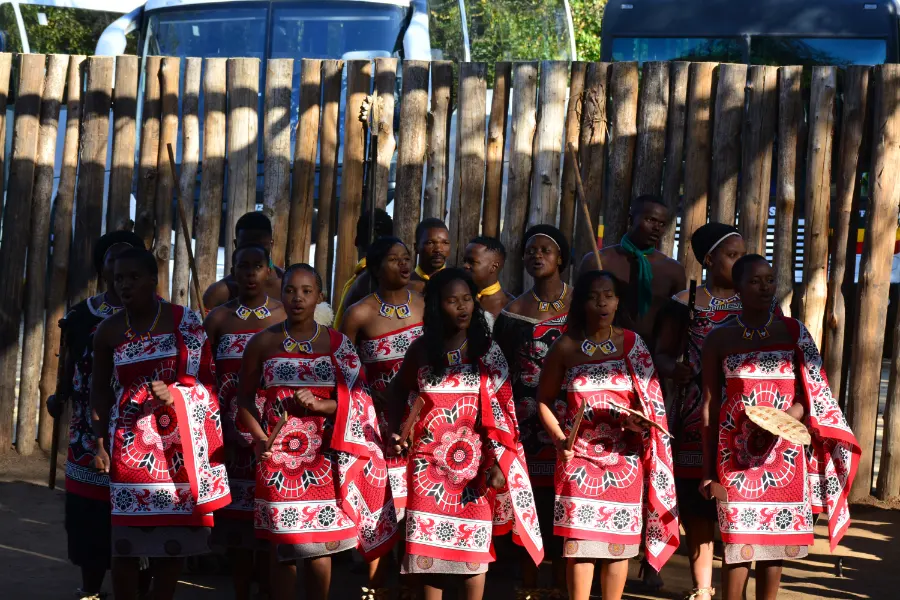
Before or after the tour of the village (depending on the schedule) you will be taken to the main area of the village, and you will have the chance to watch a traditional Swazi song and dance performance.
This was one of the highlest of the visit to Mantenga Cultural Village and the enthralling harmonies were beautifully performed and I was impressed by the vocal and visual spectacle.

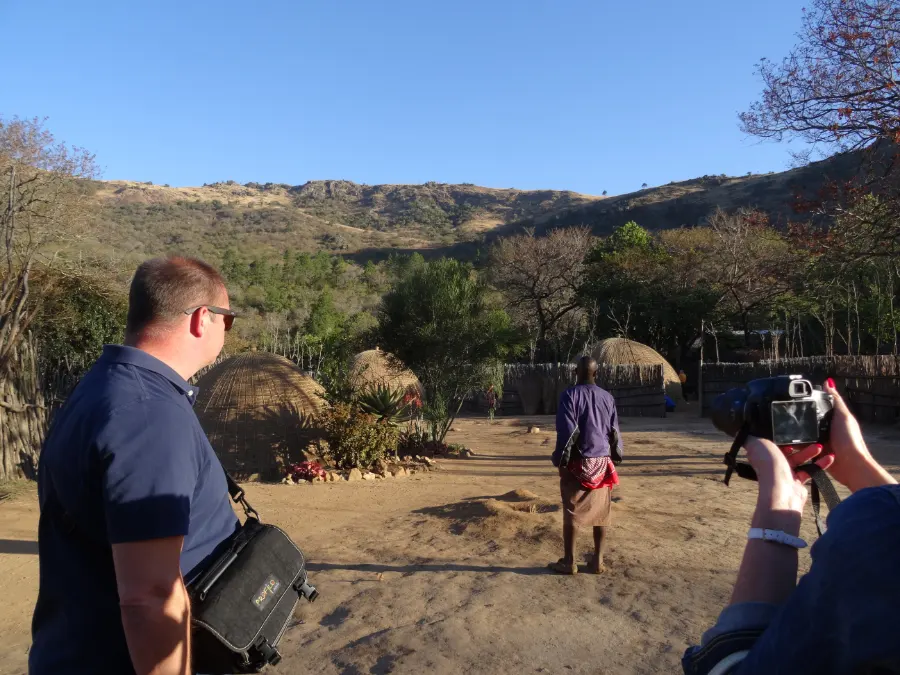
Mantenga Falls
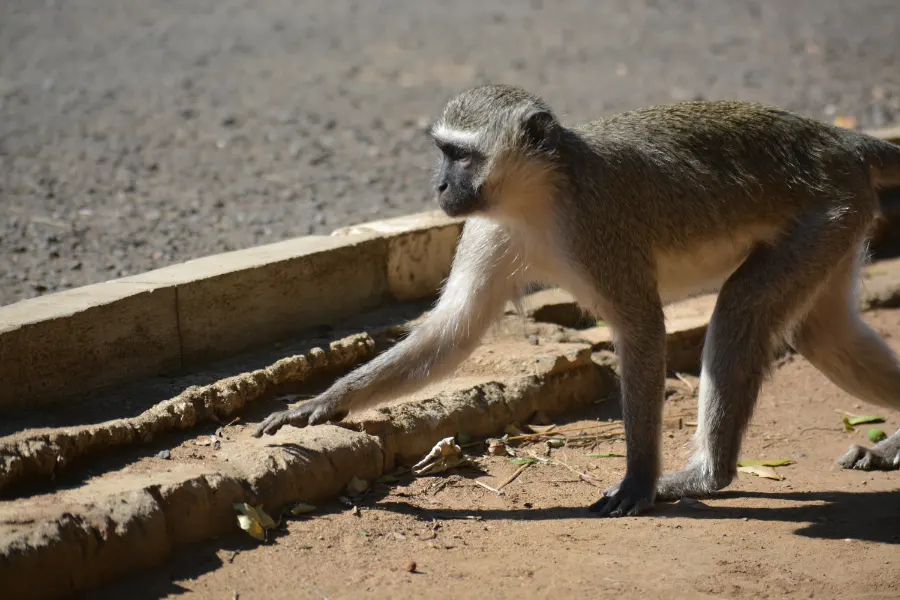
One of the main attractions near the village is the Mantenga Waterfall, which is the third stop on the itinerary that is included in the tour of Mantenga Cultural Village (and all that for R150!). It’s just a small, not-strenuous hike to the falls, and even though the falls itself are not that spectacular, you’re still in Africa so wildlife is always around the corner.
You are very likely to see the vervet monkeys that hang around the lodge, hoping for handouts. The village is worth the stay, and we had a lovely day in eSwatini. Next time we visit, we’ll be sure to extend our trip here by a few days to really experience what this tiny country has to offer.
Day 6-7: Kruger National Park (South)
The drive to Kruger National Park and what to see on the way
Look, I am normally all for creating a road trip when going from destination to destination, but on this 3 hour drive from Mantenga Cultural Village to Malelane, all you want is to get to Kruger. So, in order to get to Kruger Park quicker, skip the stops and finish the drive in one go!
Where to stay in Kruger National Park (South)?
There’s your first conundrum – where do I stay in this enormous, country sized national park? When doing our research, we found that two different locations for these 4 days would be the best bet. Many people chose to stay inside the park, but as our trip was relatively last minute, almost all of the accommodations were fully booked and we didn’t have that option.
We landed on Malelane and Hazyview – two hubs, located very close to park gates. Malelane, close to the eSwatini border and located near Malelane gate, hosts a wide array of accommodation options.
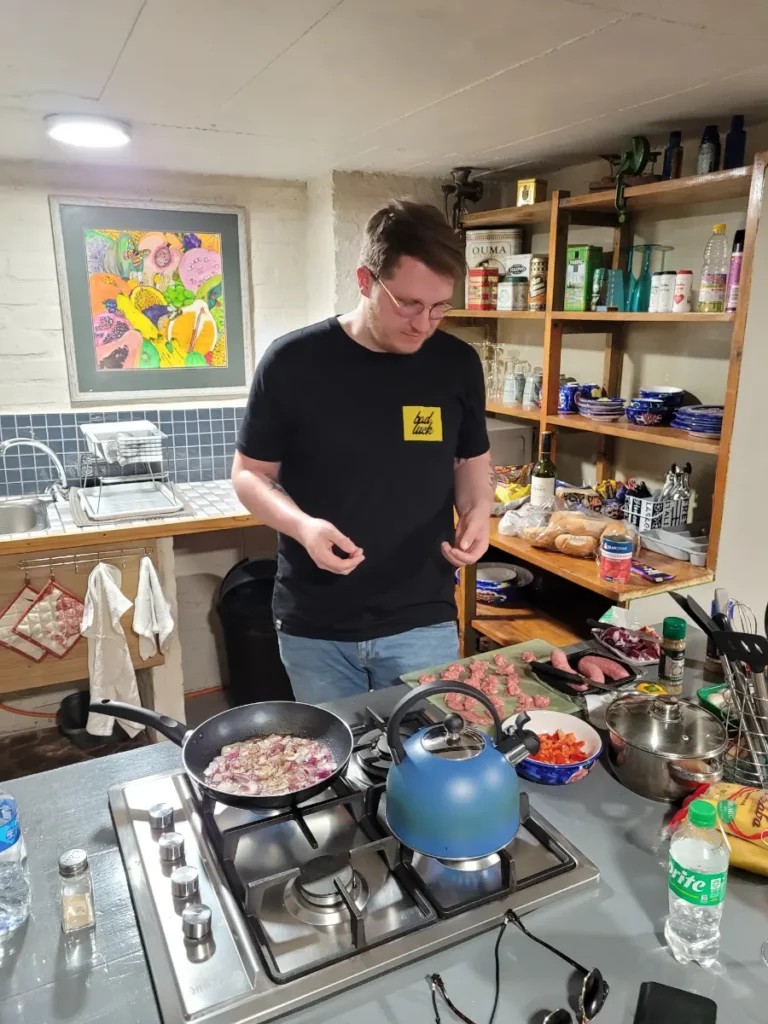

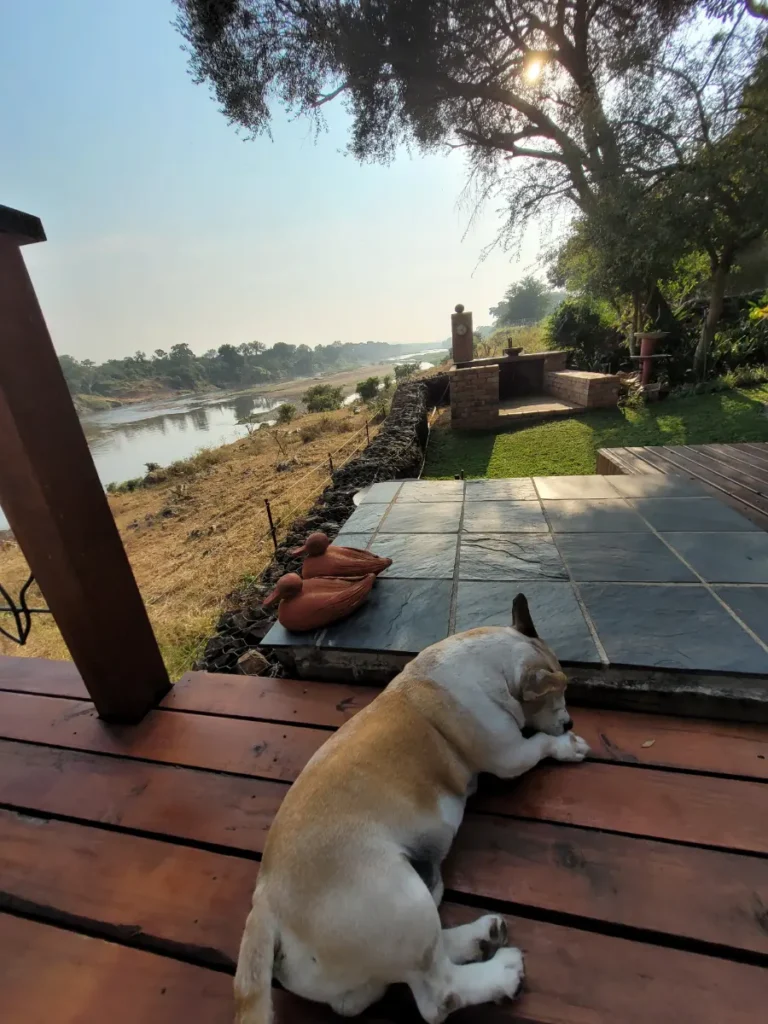
We stayed in Hennie’s Rest, directly on the Crocodile River (or Krokodielrivier in Afrikaans), and this was another lovely place. Just from hanging out in the backyard of Hennie’s Rest, we spotted different bird species, a lone waterbok, elephants and a few hippopotamuses having a swim during the day.
Our stay in Kruger was elevated to a whole new level due to Hennie’s Rest, and the owner had some great advice for us during our stay, especially on where to go to have the highest chance of seeing leopards and other predators. And – her advice proved fruitful (but more on that later). And the absolute highlight of the trip were the two dogs that roamed freely on the premises! I had the best time with Gus, and we quickly became besties.

You’ll find everything you need in Malelane, like an enormous supermarket (pictured here) and different restaurants. However, it is not necessarily a touristy town like St. Lucia or Graskop are. The vibe was quite different from what I expected from a gateway town to one of the most popular national parks in the world, but in a way it added to the charm.
The supermarket in town is a great place to stock up on supplies for a traditional, South African Braai. Much like a barbecue as we know it in Europe (and America), grilling your own meat outdoors is a big part of South African culture.
Hennie’s Rest has some Braai stations for you to use, so stock up on some high quality buffalo or beef cuts and start grilling!
What to do in Kruger Park (South)?
Kruger Park is one of the most famous wildlife parks in the world, and is comparable in size to the Netherlands (!). It remains one of the most impressive wildlife experiences one can have and just by driving around the park, you will see countless different species ranging from impala’s to the elusive leopard.
You will feel the rush of being on the constant lookout for one of the Big Five, which is not guaranteed – which makes it all the more rewarding when you do find all five species. You will look at a rock or tree stump for 10 minutes – all the while you were sure that it was a leopard. Anyway, it is truly a magical experience. I’ve visited this park twice now, and if I could move anywhere in the world it would be on the border of Kruger. I just love it that much, and I would love to be able to visit more often!
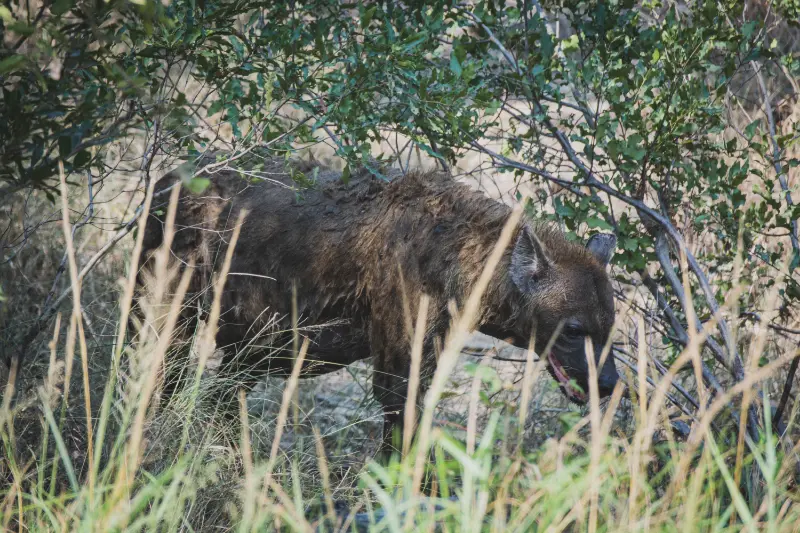

It is very daunting to figure out how to visit Kruger Park, mostly because of its size, and that’s where I come in! You can stay here as long as you like. On our first trip in 2016 we stayed for 2 days, which definitely felt like it was a rushed visit and I wouldn’t recommend staying for only 2 days.
This time around we stayed for 4 days, in two different locations, and it still felt like we only visited a fraction of what the park had to offer. Honestly, if you have the time, visit for a week. You will be able to visit the northern section of the park, which is much less traveled and has a completely different ecosystem from the more popular southern parts. If your time is limited, like mine, 4 days does do the park justice. Let me take you on our trip!

As we’re based in Malelane for these 2 days we will be using the Malelane gate which is a short 15 minute drive from our acommodation at Hennie’s Rest.
The first, super important advice I will have to give you is: GET THERE EARLY. On our first day we were tired from driving and decided we could visit slightly later in the morning (09:30) and there was an enormous line to get in.
We had to wait over an hour in the blistering sun (and it was only 28 celcius), and regretted not getting into the park earlier. The lines appearently start forming 30 minutes after opening, because the process to get into the park is quite outdated and park staff isn’t equipped with the big crowds coming in to Malelane gate.
As you enter the park from Malelane gate, you will probably be overwhelmed by the options. There are asphalted main loops that will take you deeper into the park, and gravel loops that will usually take you closer to the action. Now, just like what I wrote in the Hluhluwe-iMfolozi part, there’s no point in disclosing exactly where I saw which animals.
However, there was one road that was particularly well visited every time we went there. The owner over at Hennie’s Rest actually said we should drive this loop, and just on that loop we saw multiple hyena’s, (a glimpse of) a leopard, elephants, giraffes, an osprey and more. The loop is S114, very close to Malelane gate – and according to locals we spoke to it is nicknamed Leopard Loop.

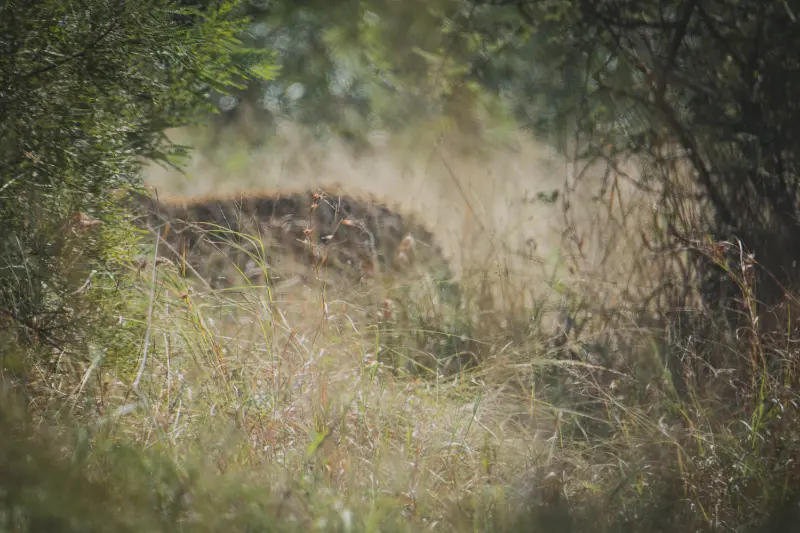

We were very excited when we spotted the spotted hyena (heh), as it was the first predator on our entire trip! We had finally broken the herbivore curse, and we got a very good look as he was panting quite near to our car. And a few miles down the road, we saw a bunch of cars on the sides of the road and a large feline creature sprinting away in the bushes to our left. I was just fast enough to snap the picture above, but the leopard dissapeared into the thick bush and we didn’t see a leopard for the remainder of our trip.
So, I guess, we technically completed 4/5 of the Big Five, but we kept hoping we would see a leopard properly for the remainder of our trip, but they never showed themselves. Nature is fickle, even in Kruger!
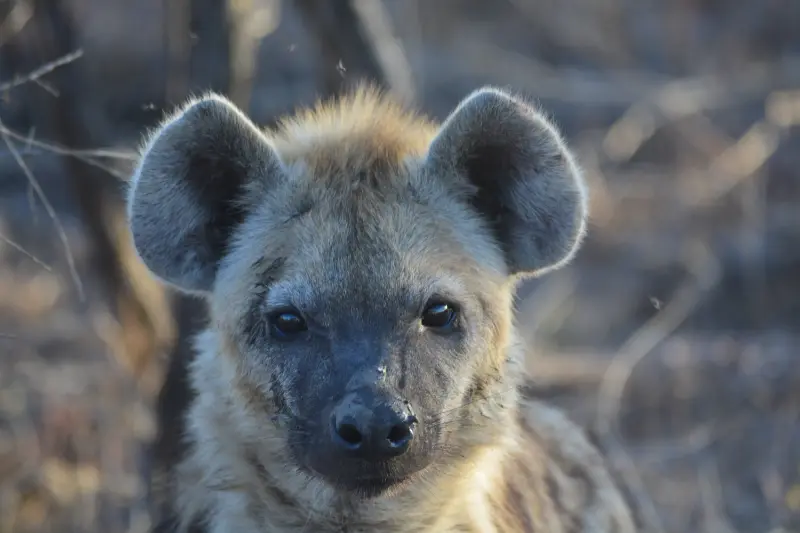

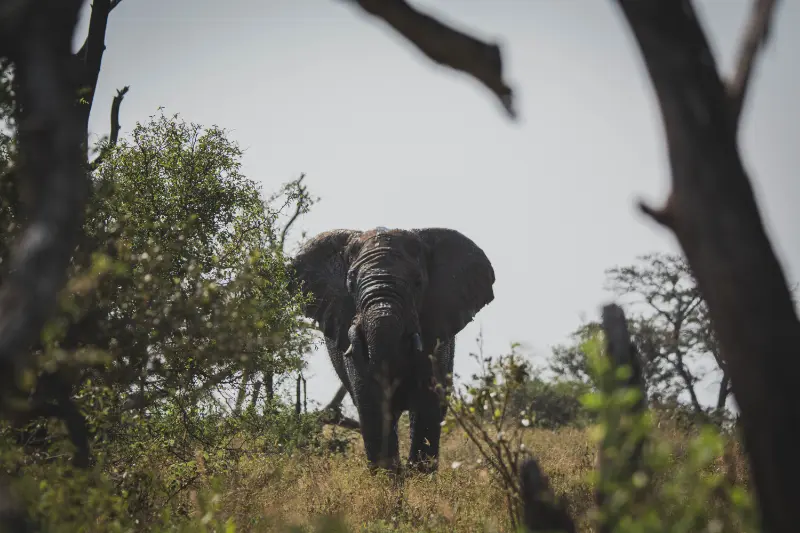
Time moves quickly in Kruger, and it will be afternoon before you know it. Grab lunch at one of the many rest stops in the park, the bobotie sandwiches at Boskombuis are amazing, and get lost in Kruger. There’s not much else to say for the car-safari experience in Kruger, but I can show you some more pictures trying to convey a sense of what you might see!

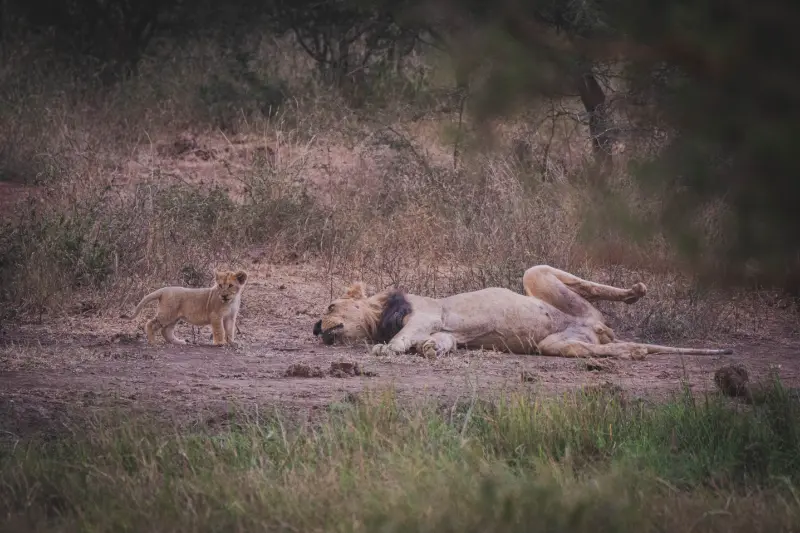


As you can see, we got extremely lucky with some a lion family gathering in the beautiful dusk lighting in the late afternoon. And just 30 minutes before that, we saw the lone male depicted above stalking an entire herd of water buffalo. He was biding his time for a long time, until he decided it wasn’t worth the risk and sadly took off.
All of the above pictures, including the hyena, leopard and other pictures, were from just one day of self driving in the south of Kruger! The park really lives up to it’s name as one of the premier safari destinations in the world.
Another tip I can give you though, is make sure you get out of the park before closing time. Because we found all these lions near closing time, the last stretch of our drive took a long time and we only barely made it out in time. You will get fined if you’re not out in time, so that’s something to keep in the back of your mind.
The next day we went for some more loops, but we arrived early in the morning. We didn’t get as lucky as the first day, but still had plenty of encounters with the local fauna. Another impression:

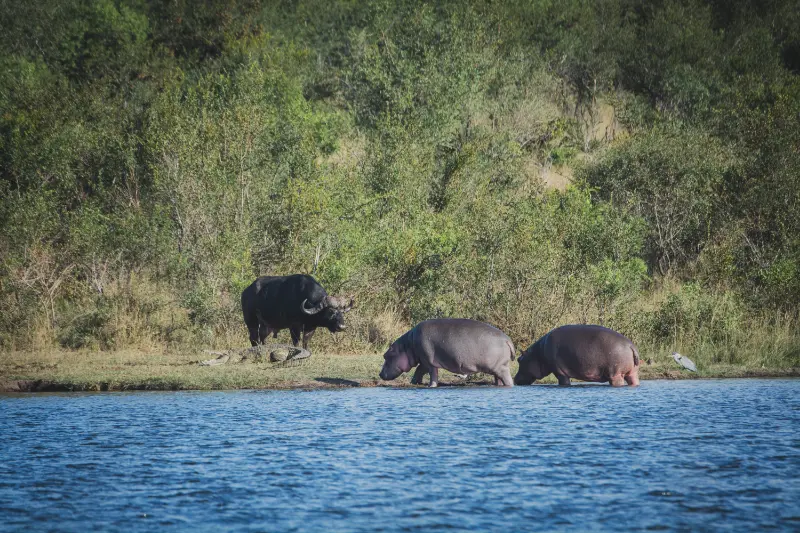
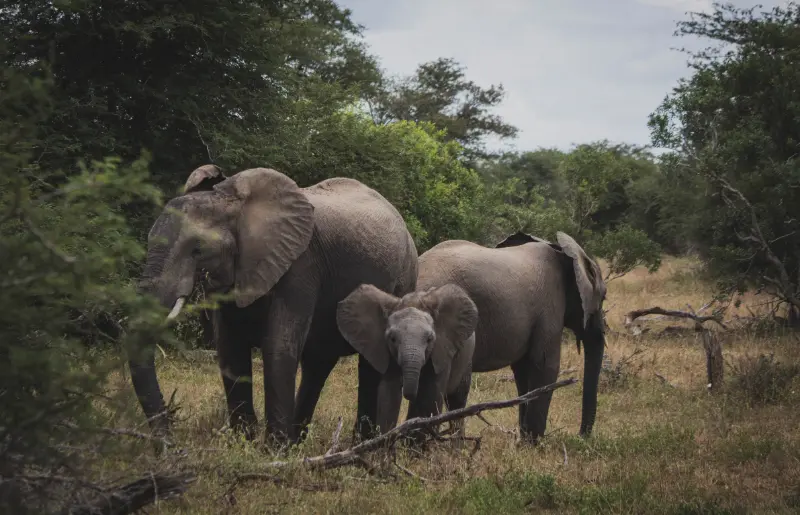

Day 8-9: Kruger National Park (West)
The drive to Kruger National Park and what to see on the way
When driving from Malelane to Hazyview you drive through Kruger Park, and when you feel done with the safari day you drive out of Phabeni gate in the west and check in to the resort. One tip: DO NOT use the Numbi gate, just south of Phabeni. Last year, a German tourist was killed there and there have been numerous attacks on vehicles that leave or enter Kruger from that gate.
We took the main road trough Kruger (S118) and it seemed like today was Elephant day. We saw sooooo many herds of Elephants, lone bulls, little ones. The feeling of seeing wild African Elephants from just a few feet away is incredibly awe inspiring. They are unlike any other animal in the world, and their intelligence is just tangible. Just make sure you keep a safe distance, as especially young males have a tendency to charge vehicles if you come too close.
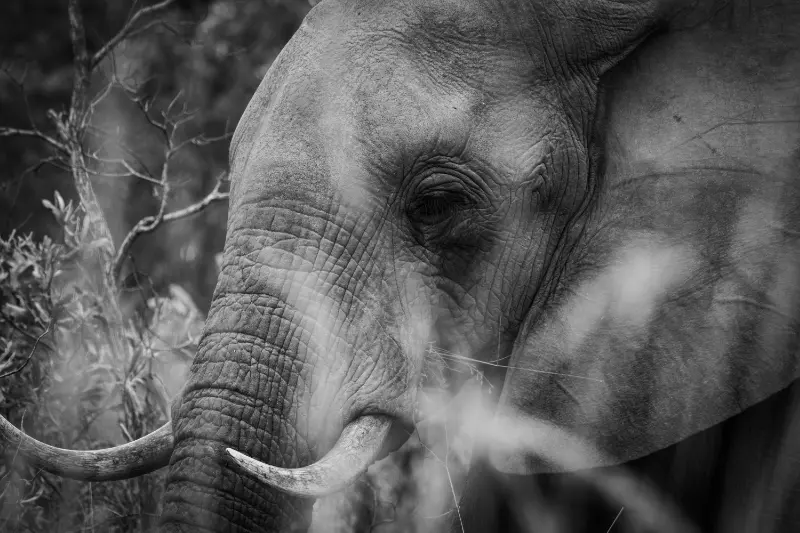
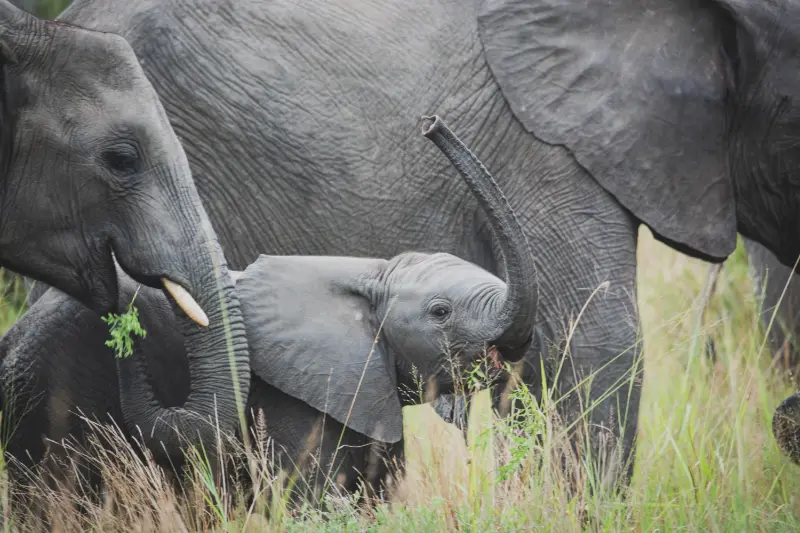
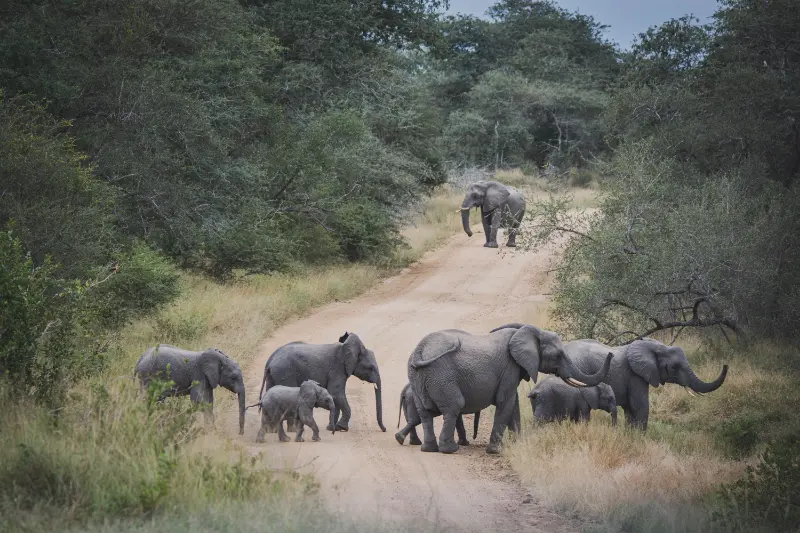



Another memorable encounter is one we had with two hyena’s, and I shot maybe the best and most gruesome picture I’ve shot during this safari trip. Check it out!

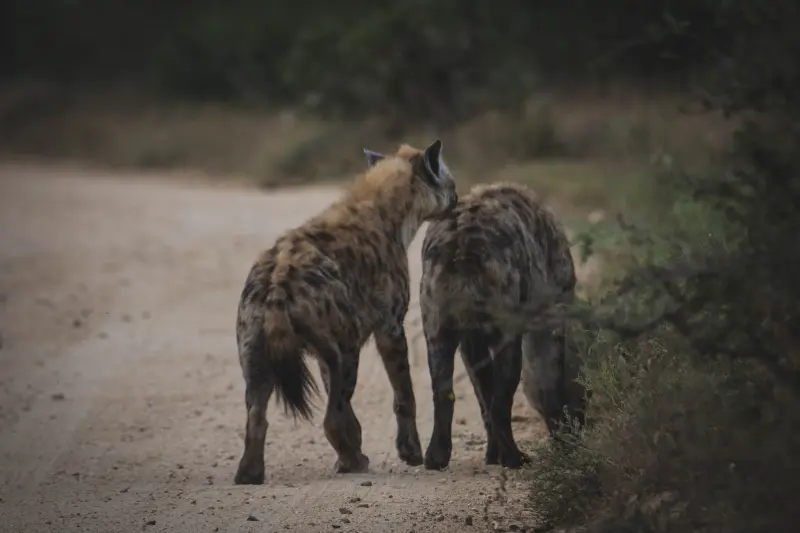
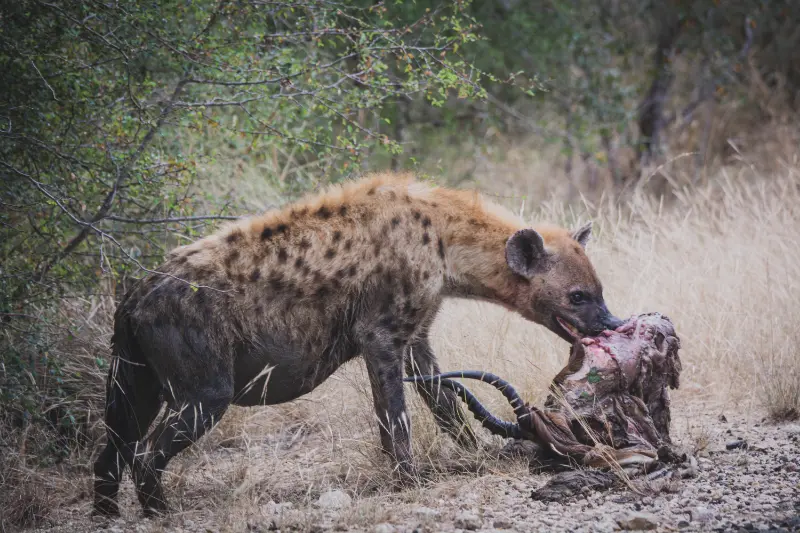
Where to stay in Kruger National Park (West)
Hazyview is another great town to base yourself in for your second stay near Kruger. Much like Malelane, Hazyview doesn’t have that national park gateway touristy town feel that you might find in other places (like St. Lucia and Graskop) but it has everything you need and some amazing accommodations.
We stayed in the Kruger Park Lodge, which was just a 15 minute drive from Phabeni gate (as mentioned don’t use Numbi gate). On the premises there’s a lovely restaurant (where we finally found the traditional South African dish Bobotie), a nice park, a pool, a playground and a small body of water connected to the Crocodile River, which runs through Kruger, where you can see hippo’s if you’re lucky.
There’s also impala’s and other harmless ungulates on the premises. A great place to stay for 2 days and to relax when you’ve spent all day driving around looking for wildlife.


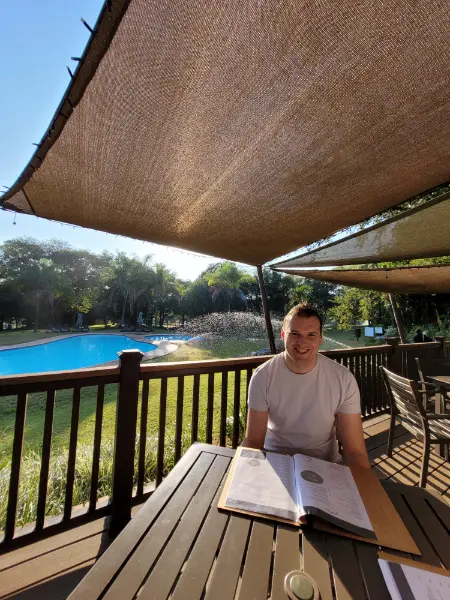
What to do in Kruger National Park (West)
Until now, most of our safari experience has been self-drives. Although we did want to book a guided jeep-tour, all tours were fully booked during our time in Kruger. If you want to go with a guided tour, make sure you book in advance!
We went in early again, but after so many days of safari you reach a point of saturation. We didn’t stop for zebra’s or giraffes anymore and were completely fixated on finding another leopard. We spent all day in the western part of the park, and we saw many more different species, but we weren’t lucky with another leopard.
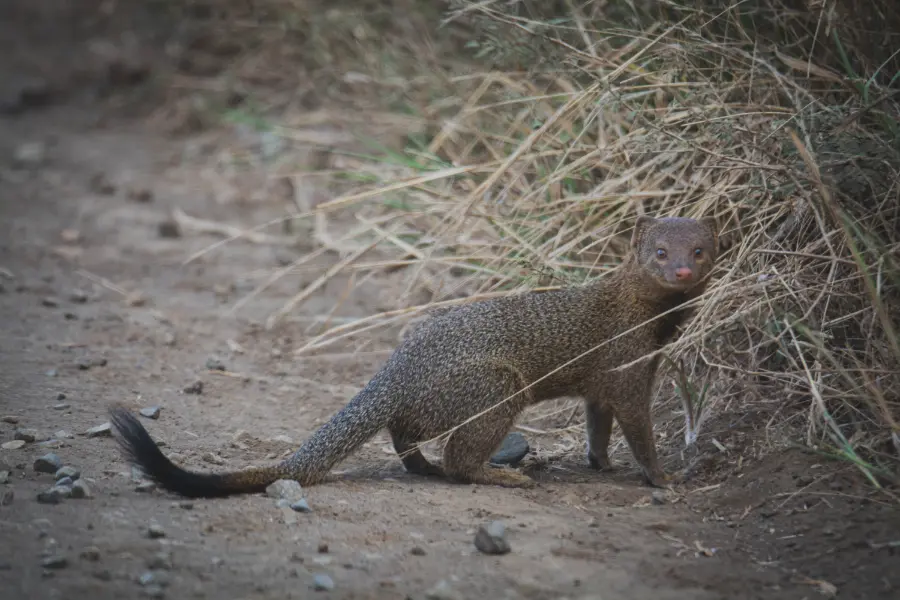
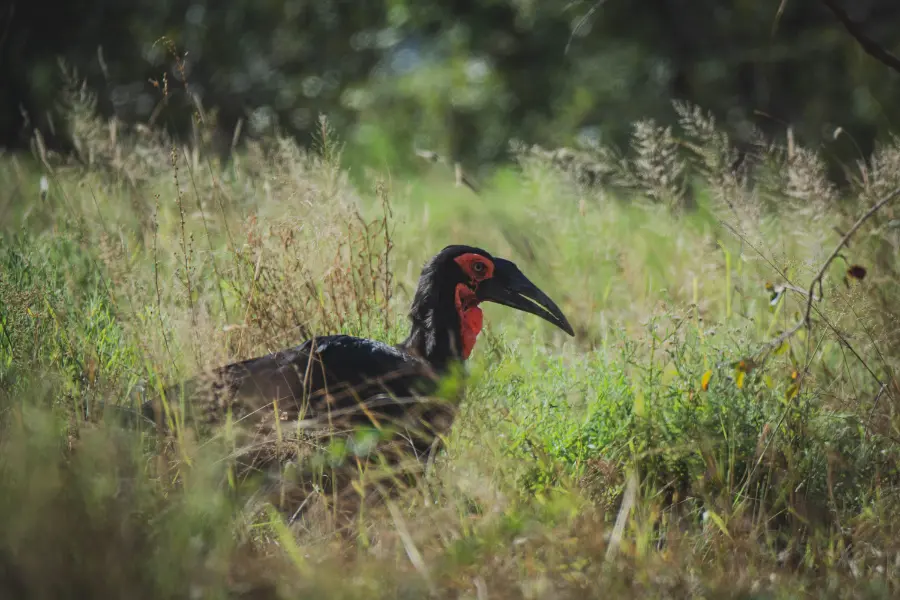
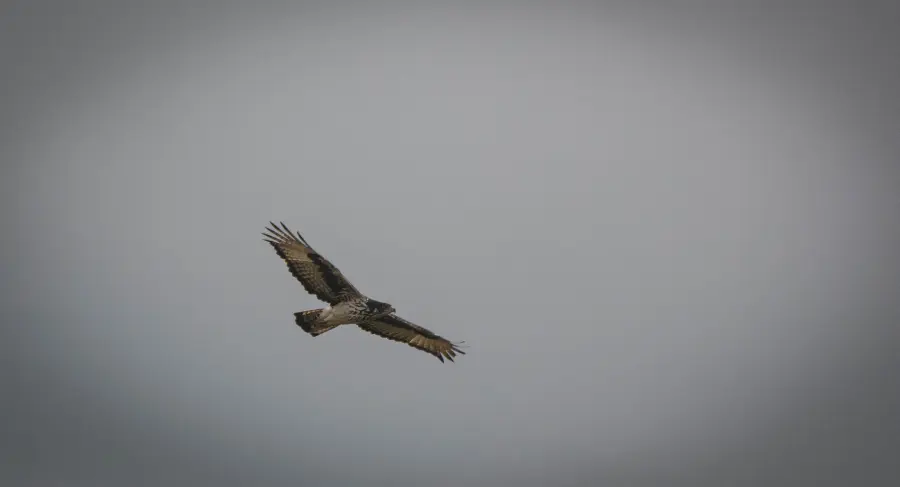


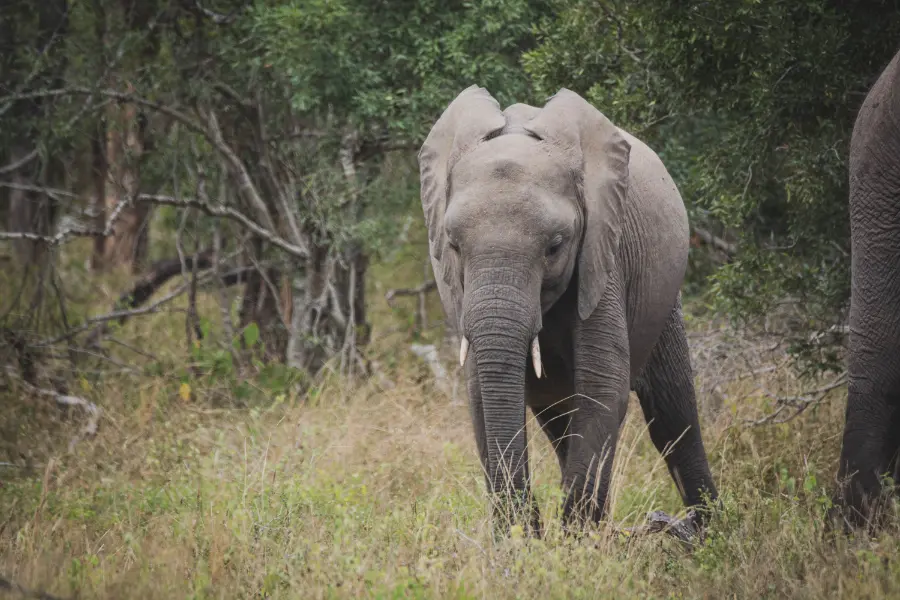
From Hazyview you can get to Skukuza via the S1, but what we did was take the first left and follow the road that is constantly following the Sabie River. Even though we didn’t get lucky with a leopard sighting, maybe you will!

You can have some amazing breakfast, lunch and/or diner at Skukuza camp, buy souvenirs, book tours and much more. It’s also a great place to stay if you do book well in advance, because you’ll be on the road into the park very quickly from here.
Skukuza has different restaurants, the Cattle Baron (pictured to the left) where you can have breakfast, lunch and diner while overlooking the Sabie River. We had breakfast here and it was delicious.
There’s also the Kruger Station Restaurant, where we had a cold coke, beer and some lunch. It was a nice break from the safari and has that touristy feel that I feel is not there in Malelane and Hazyview.
It also has a gas station (like most bigger camps in Kruger) so it’s always wise to fill up on gas while you can!
We spent the remainder of the afternoon driving back to Hazyview before we spent some time relaxing at the resort with a good book. On the drive back, once more past the Sabie River loop, we saw some more babboons, hippo’s, giraffes, zebra’s and the cherry on top: our final lion in Kruger.

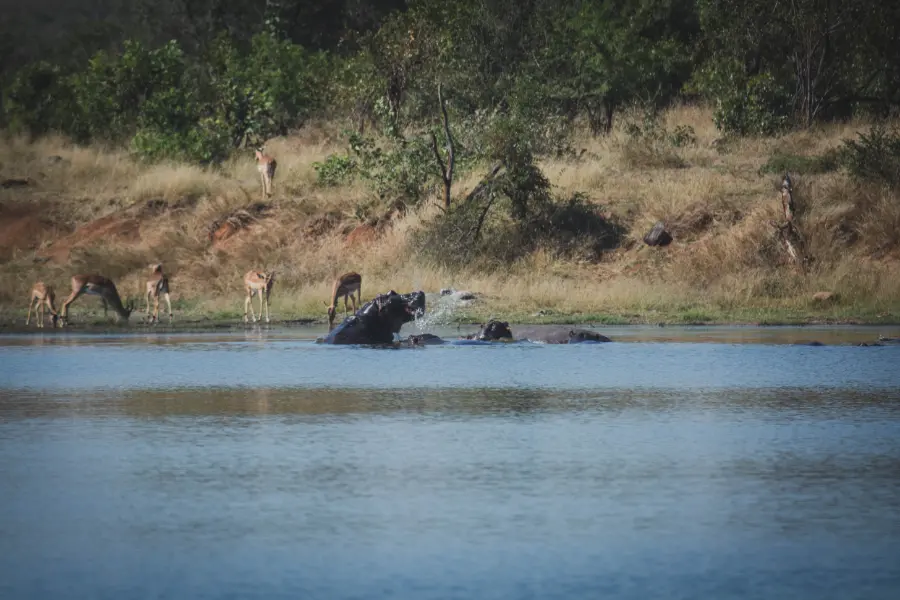

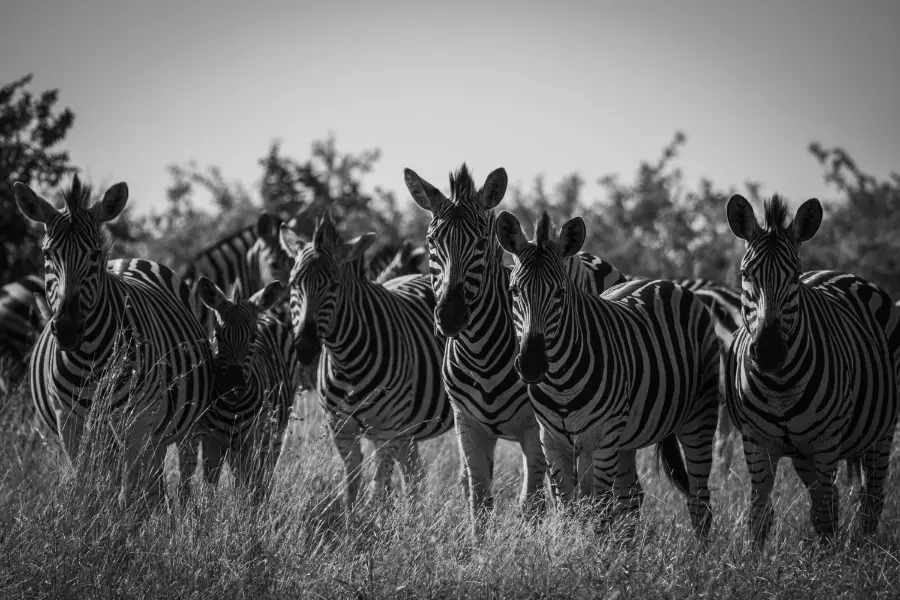
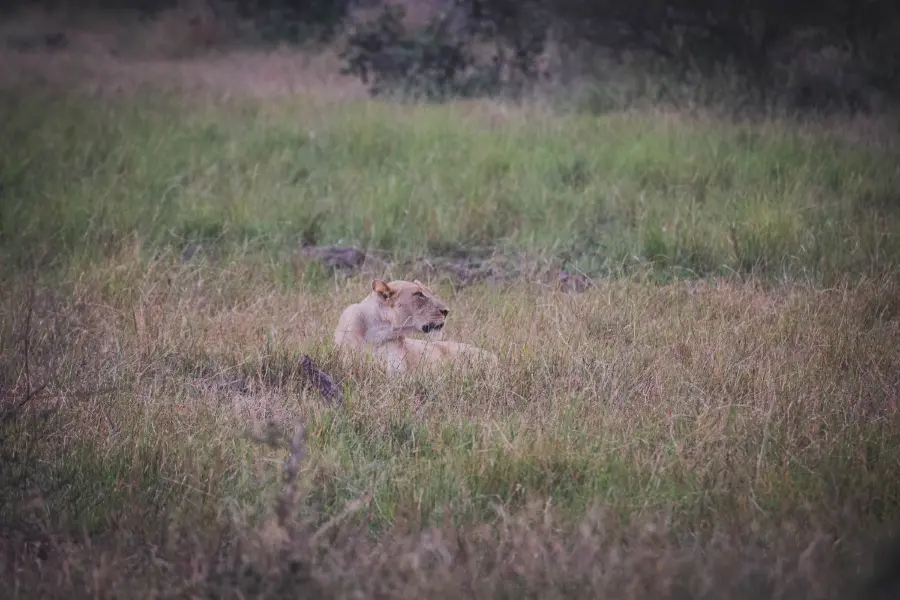
On our last day in Hazyview we decided to hang out near the lodge, go for a swim in the pool and take it easy to take a break from all the driving and looking for wildlife.
Day 10&11: Graskop
The drive to Graskop and what to see on the way
Since the journey from Hazyview to Graskop is just 30 minutes, the amount of stops along the route is rather limited. It’s advisable to gather supplies in Hazyview, as it boasts a wider range of stores compared to Graskop.
Where to stay in Graskop?
We stayed at Graskop Hotel, a cozy retreat in the heart of Graskop, in the middle of the centre of town! There’s a lovely garden adjacent to the apartments, and there’s a lovely pool, with some lounge chairs. There’s not many restaurants in Graskop town, so it helps that there’s an on-site restaurant in Graskop Hotel if you can’t find a place to eat (which is what happened to us)
What to do in Graskop?
Graskop is a lovely small town that’s just a 34 minute drive away from our last stop Hazyview. It is generally known as a great base to visit the neighboring natural wonders and a starting point of the Panorama route. The town itself has a couple of restaurants (and an amazing lunchroom called Harry’s Pancakes, more on that later), and plenty of lodging options.
The Panorama Route
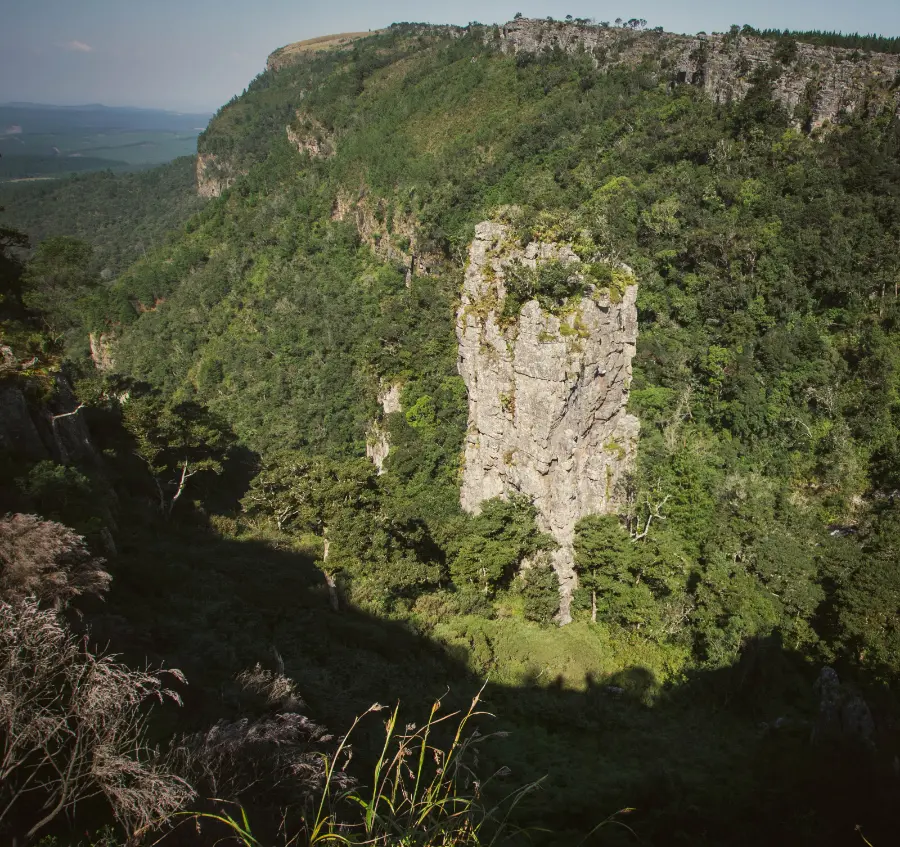
The first stop on the drive is Pinnacle Rock. A cool place to stop, but not super impressive. There’s just a pathway to a viewpoint, and there’s no trails to get closer to the pinnacle.
It’s a very quick stop and a nice way to warm up for the geological spectacle that awaits on the road trip today!
The next stop is a real gem known all over in South Africa: God’s Window. It’s got quite the reputation among locals and tourists alike, and you’ll even find locals selling handmade souvenirs right at the parking lot where the trail begins. The walk up isn’t too tough—it’s paved—but if you’re not exactly in tip-top shape, you might feel it a bit. But trust me, it’s worth every step!
The views from the top are just jaw-dropping, and you can reach the first viewpoints in about a seven-minute walk. They’re an absolute must-see. Check out the two pictures below; they’re from the second viewpoint. And if you look closely, you might spot me and my brother on the first one. Absolutely gorgeous!

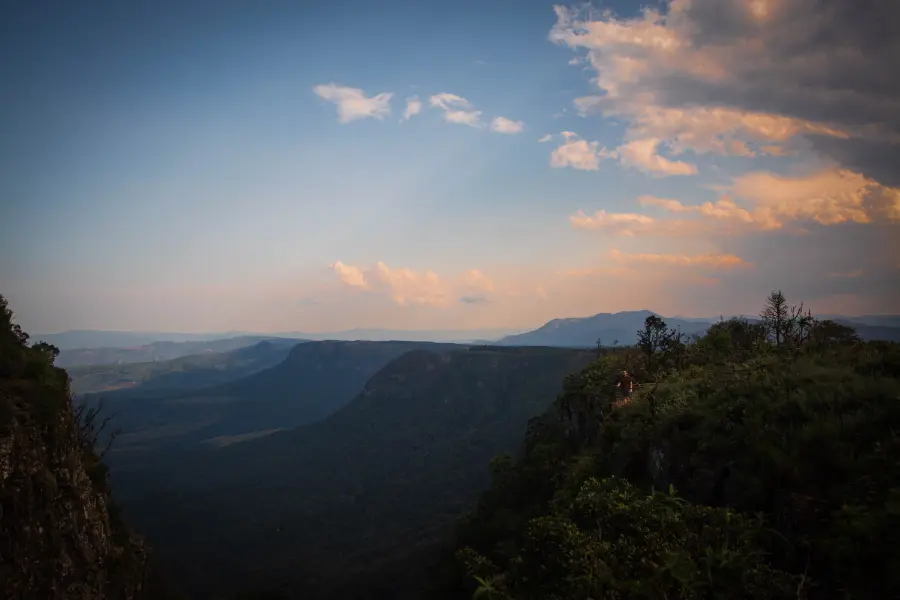
If you’re short on time or not up for a longer hike, you can opt to visit the initial viewpoints and call it a day. However, I highly recommend continuing along the Jungle Trail – despite its intimidating name, it’s actually quite manageable. Beyond the God’s Window viewpoints, a further 20-minute walk leads you to the summit of the mountain, offering another perspective where you can gaze out over Mozambique and the vast expanse of Kruger National Park.
Surprisingly, the highlight wasn’t just the view. About five minutes into the ascent, the ecosystem undergoes a sudden transformation, revealing a small stretch of jungle enveloping the trail, creating an enchanting atmosphere. At the mountaintop, there’s a unique ecosystem that results in a permanent, albeit slight, rainfall, creating lush vegetation in this compact area. It’s a delightful and unexpected experience, and one of my favorite stops along the panorama route.
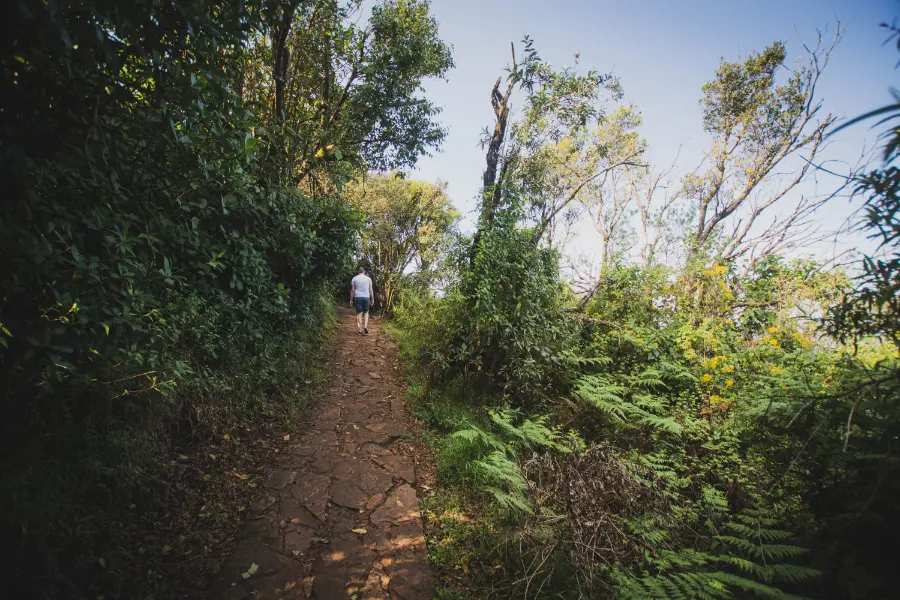

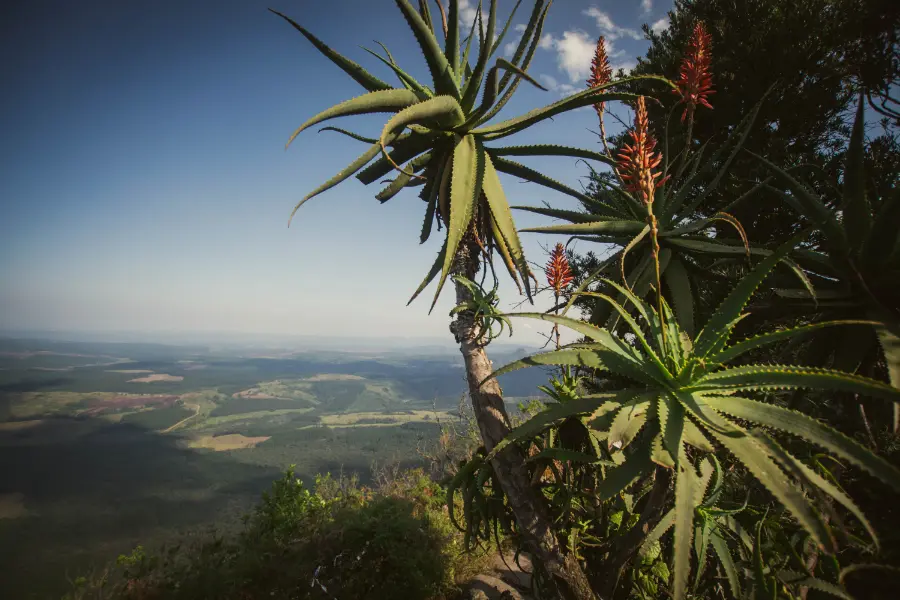
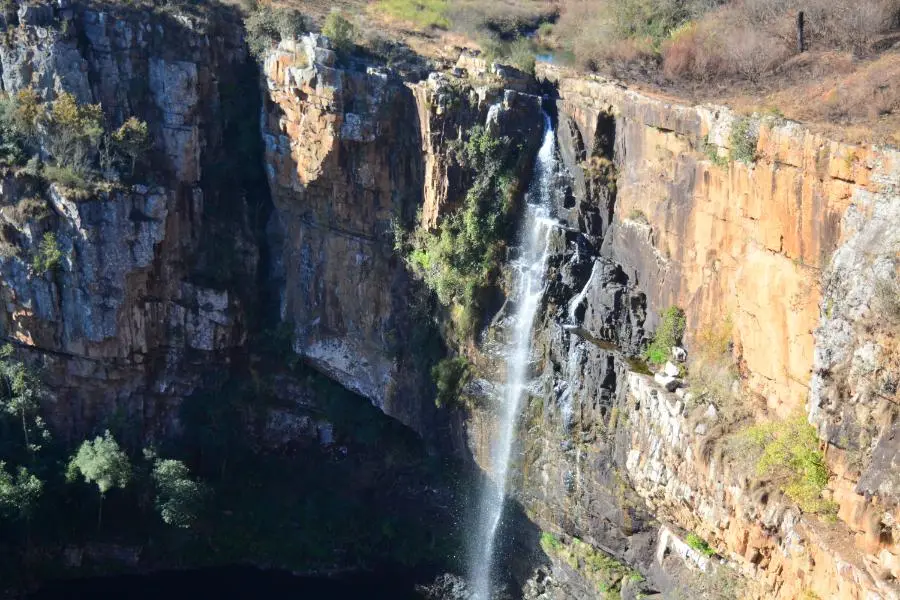
Merely five minutes down the road lies the Berlin Falls. However, upon hearing from some locals that the road ahead might be closed, we made the decision to press on, aiming to reach Bourke’s Luck Potholes and the Three Rondavels before any closure.
Back in 2016, during a trip with my parents, we did manage to visit the Berlin Falls, so I’ve included a picture for reference. While it might not be the most picturesque waterfall, it’s likely more impressive during the rainy season (this picture was taken in July)!
30 minutes down the road you will find, in my opinion, the most special and beautiful stop on the panorama route: Bourke’s Luck Potholes. Tucked away on the side of the road, Bourke’s Luck Potholes stand as a stunning testament to nature’s artistry. A quick hike gets you there, making it a perfect stop for any traveler on the panorama route. The photo ops are unreal, with the swirling water and unique rock formations providing some great shots.
You can’t help but be amazed by the size and beauty of the potholes, formed over countless years by the power of water. It was truly a mind blowing experience and I loved it, however my non-photography nerd compatriots didn’t care for it as much as I did (they still found it impressive, though).
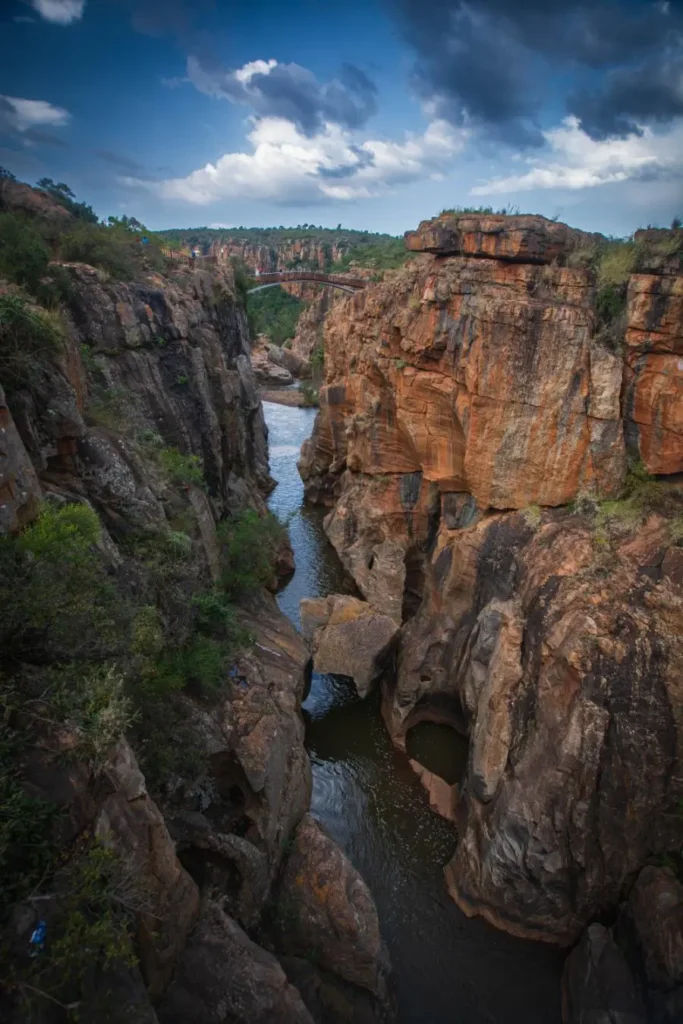



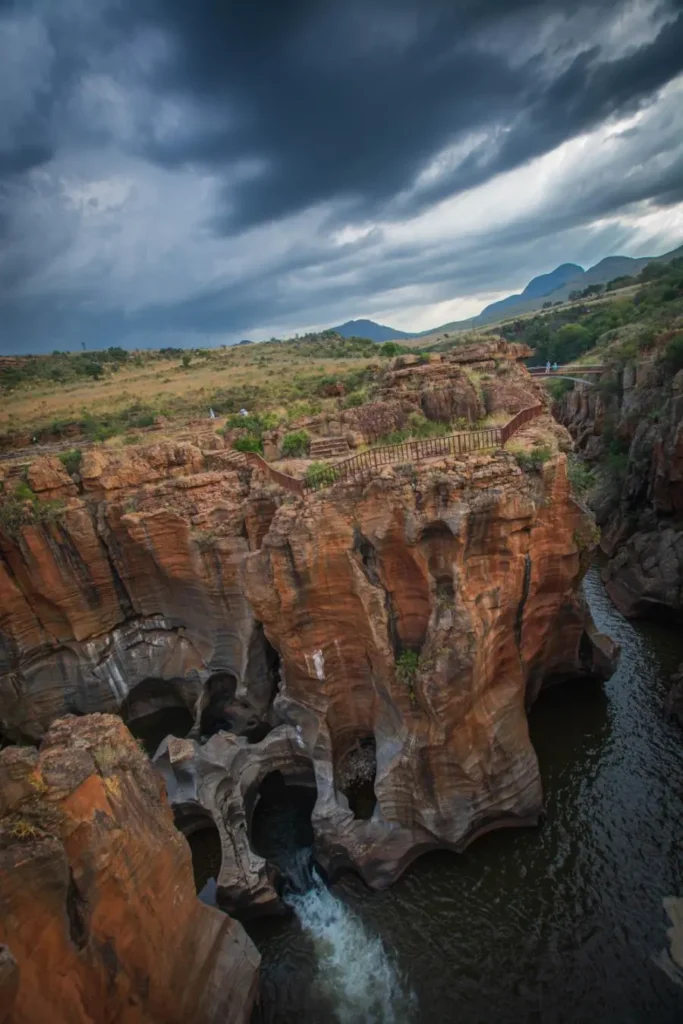
The final stop on the panorama route and the main sight according to most travel guides out there, are theThree Rondavels. It’s a remarkable sight, featuring three imposing rock formations resembling traditional African huts, hence the name ‘rondavels.’ Unfortunately, on our recent trip, we were unable to see them due to the mentioned road blockade caused by a protest.
However, we did manage to capture some stunning images during our visit in 2016. This spot truly stands out as one of the most breathtaking destinations in all of South Africa, reminiscent of a green Grand Canyon. Don’t skip this one, and I hope the road isn’t blocked when you go there!


After driving the Panorama Route circle back to Graskop and have a nice dinner in Graskop town. Spend the next day relaxing at the pool and reading a book, as you have quite a drive ahead of you.
Day 12-14: Sun City
The drive to Sun City and what to see on the way
The final stop on our trip is the lavish and luxurious Sun City. Formerly emblematic of the Apartheid regime, reflecting the country’s segregation, it has undergone a remarkable transformation into an inclusive travel destination seeking to reconcile its dark past. Visiting Sun City today is a far cry from what it was 40 years ago, with a concerted effort towards sustainability and inclusivity evident throughout the resort.
Making the journey to Sun City is a choice, adding a lengthy six-and-a-half-hour drive to your itinerary. However, as we later elaborate in this section, we found it to be well worth the travel time, offering a perfect opportunity to unwind at the conclusion of our trip. Given the lengthy drive, I suggest skipping any stops along the way, except for quick breaks to pick up snacks and refuel. Just keep driving until you’re greeted by the sight of luxurious pools and bustling slot machines!
Where to stay in Sun City?
There’s a lot of options for a lot of different budgets in Sun City. From lavish and luxury to a nice family friendly place. It can be quite daunting to figure out where to stay, so I wrote up a little guide on where to stay depending on different factors, based on the description of Sun City’s website.
- The Palace of the Lost City: This luxurious hotel is an architectural marvel, inspired by a mythical African kingdom. With its opulent decor, lush gardens, and cascading water features, The Palace offers an unforgettable experience of grandeur and indulgence.
- Sun City Cascades: This elegant hotel exudes sophistication with its contemporary design and tranquil surroundings. Nestled amidst lush tropical gardens, Sun City Cascades provides a serene retreat for guests seeking relaxation and rejuvenation.
- The Cabanas: Offering a more casual and family-friendly atmosphere, The Cabanas provides comfortable accommodations in a picturesque setting. Guests can enjoy the hotel’s laid-back vibe and convenient access to Sun City’s various attractions.
- The Sun Vacation Club: Ideal for families and larger groups, The Sun Vacation Club offers self-catering accommodation options ranging from spacious apartments to luxurious villas. Guests can enjoy the flexibility of preparing their own meals while still having access to all of Sun City’s amenities and activities.
- The Soho Hotel: With its vibrant ambiance and lively atmosphere, The Soho Hotel is the heart of Sun City’s entertainment scene. Featuring a bustling casino, numerous restaurants, and exciting nightlife options, The Soho Hotel is perfect for guests looking to immerse themselves in the excitement of Sun City.
- The Cabana Beach: Situated on the edge of the Sun City Lake, The Cabana Beach offers stunning views and a tranquil setting. Guests can relax on the beach or take advantage of the hotel’s water sports and recreational activities.
During our visit to Sun City, we stayed at Sun City Cascades, where we enjoyed the serene surroundings, amazing swimming pool and relaxing atmosphere. You are free to visit the other hotels, however, and we absolutely gawked at the lavishness of the Palace of the Lost City.

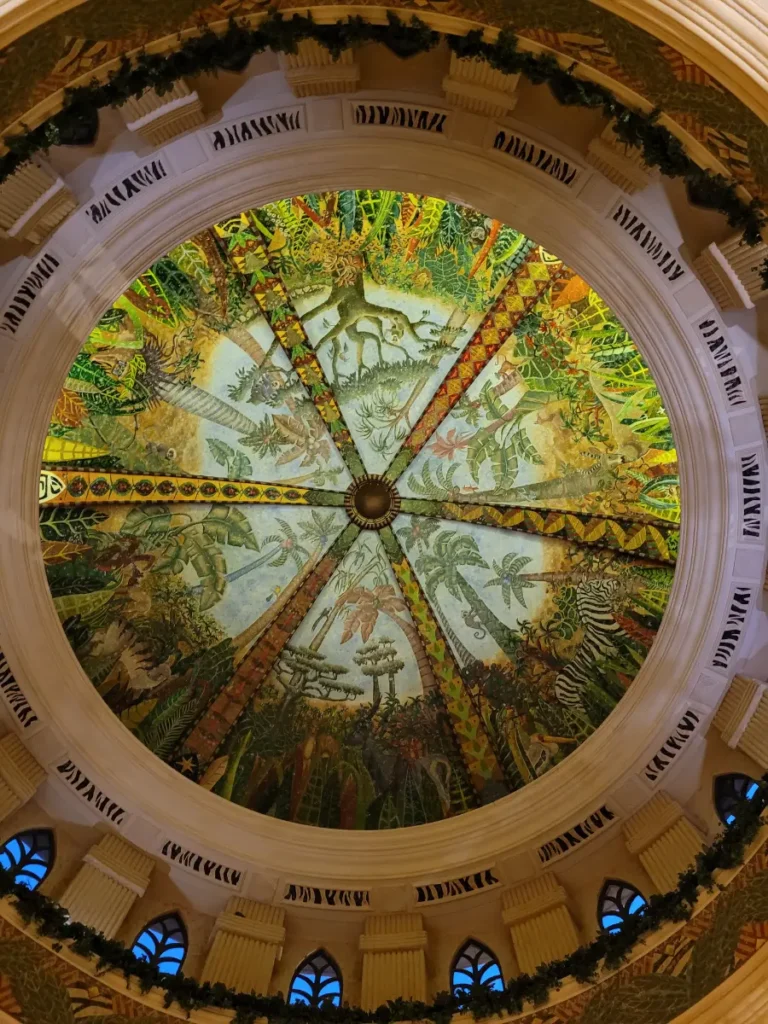

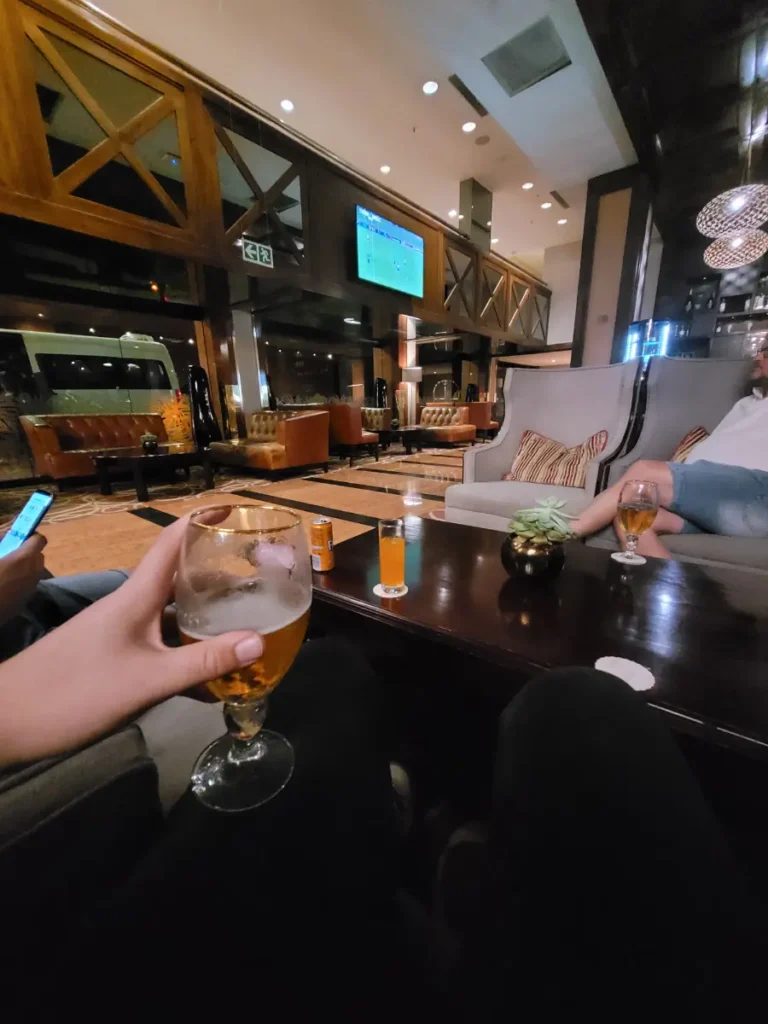
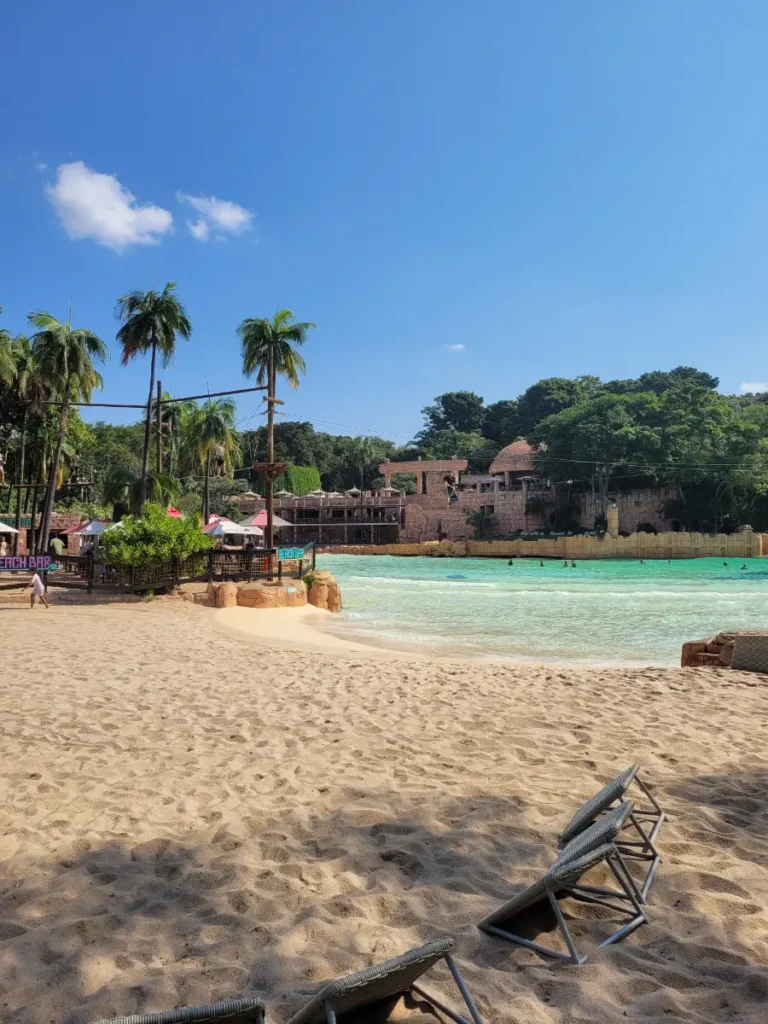
What to do in Sun City?
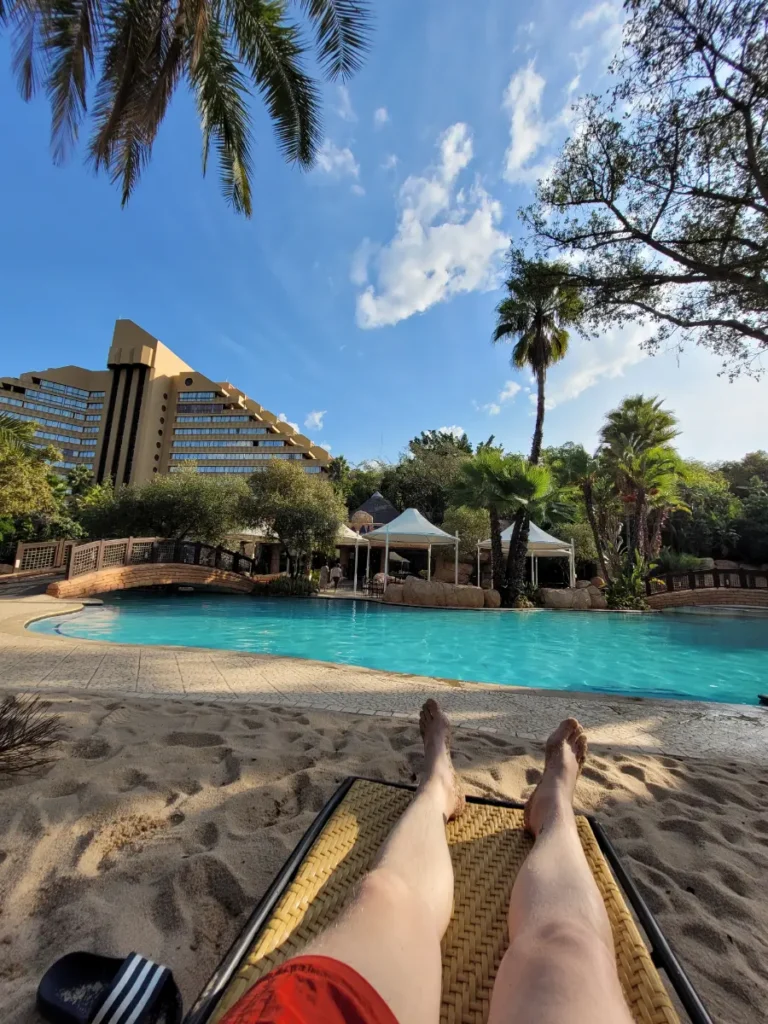
The final stop on our road trip around South Africa, Sun City, is the perfect place to wind down after the exhilaration of a busy safari trip, offering a relaxing haven to indulge in some true holiday experience.
Situated in South Africa’s North West Province, Sun City is basically a collection of resorts offering a blend of luxury and entertainment, and it reminded me of a small scale Las Vegas. With its range of accommodations, golf courses, water parks, and multiple casino’s, it caters to diverse tastes.
You can relax by the pool, enjoy a round of golf, or explore the nearby Pilanesberg National Park if you’re not done with safari. Sun City provided a memorable end to our trip

There’s plenty to keep you busy in Sun City, but our favorite moments were spent lounging by the pool, trying our luck at the casinos, indulging in meals at various restaurants, and catching a movie at the theater (we watched Guardians of the Galaxy 3).
We also embarked on a safari trip to Pilanesberg National Park for one last chance to spot a leopard. You can arrange a safari tour from the resort’s reception area, with a driver picking you up early in the morning. We opted for a sunset group tour, but there are other options available, such as full-day tours, night drives, and private drives.
While Pilanesberg is undoubtedly beautiful, our experiences at Kruger and Hluhluwe-iMfolozi overshadowed it. Nonetheless, we did spot a lot of wildlife, and if you’re staying in Sun City for a few days, I’d definitely recommend a trip to Pilanesberg National Park
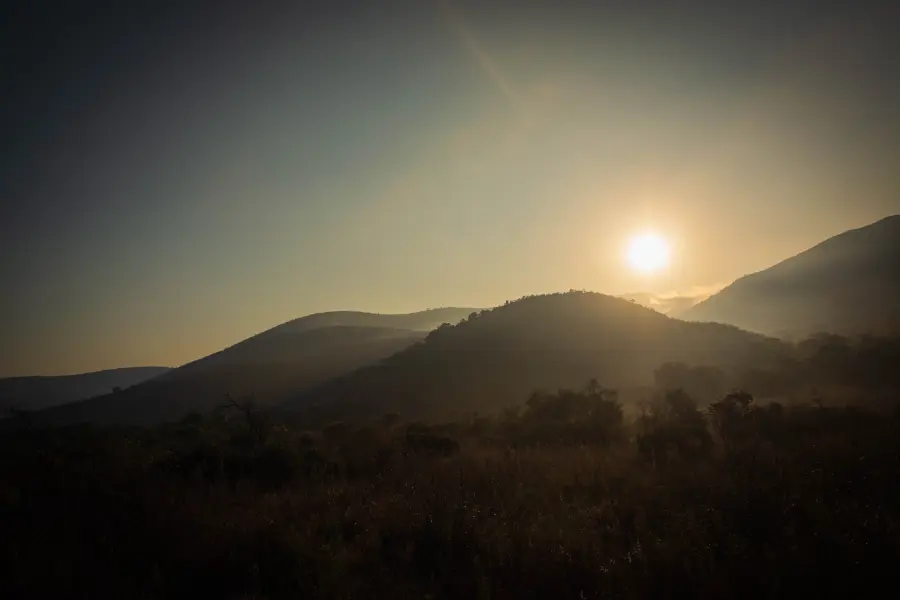
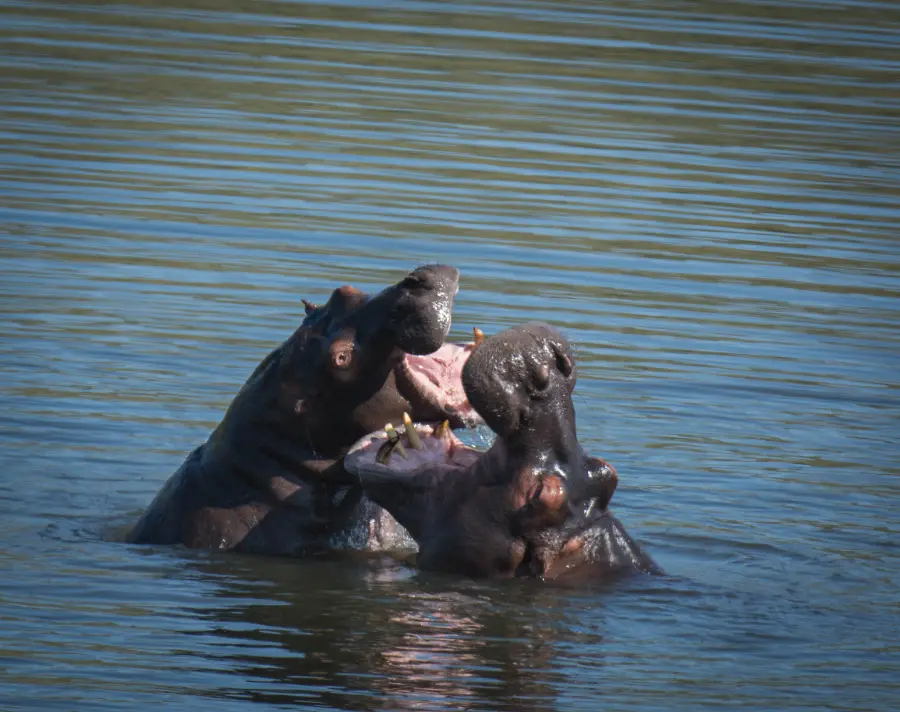
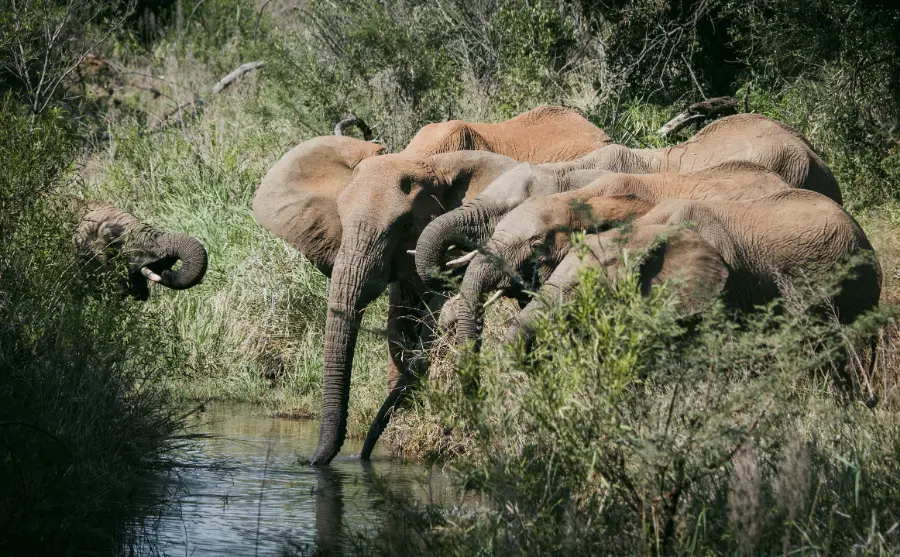

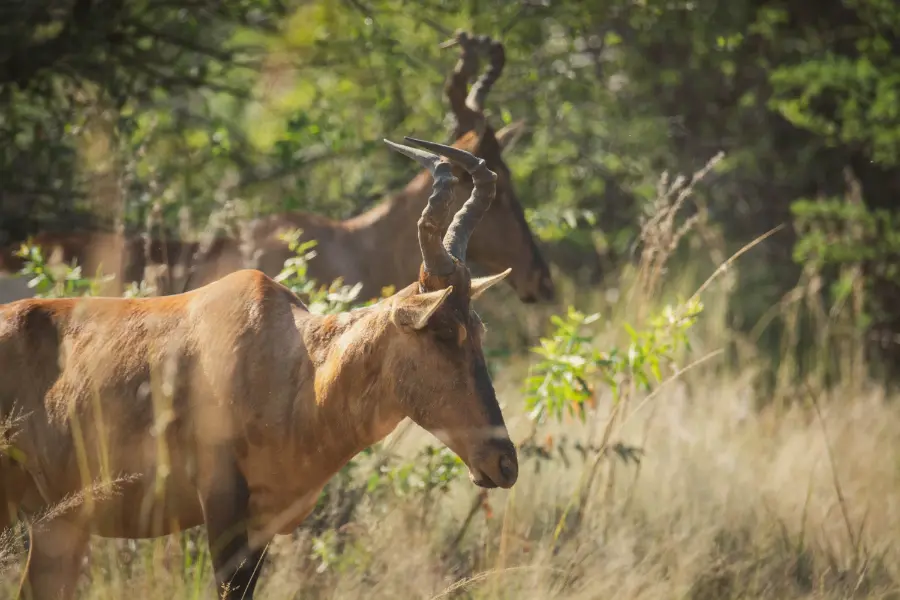

Day 15: O.R. Tambo Airport
Unfortunately, our trip was over. The drive from Sun City to O.R. Tambo Airport is about 2 hours and 30 minutes and passes trough rather uneventful terrain. We packed our bags in the morning, and drove to the airport for our late afternoon flight. We had plenty of time to hang out at the airport and hang out there for a little while for our flight back to Amsterdam via Dubai.
Final thoughts
South Africa is honestly one of my favorite countries on earth, and this trip reinforced that feeling.
- South Africa is undergoing rapid modernization, resulting in a significant expansion and enhancement of tourist infrastructure. The difference between our visit in 2023 and 2016 was night and day.
- Safari in South Africa is unlike anywhere I’ve been. The freedom to drive your own car around the National Parks is just sublime.
- I never felt unsafe during our stay in South Africa, not even when we were faced with a road block by a pretty angry mob. People are generally very very friendly.
- Sun City is a great place to finish a trip, and I wish every country I visited had a Sun City at the end of it honestly.
- It’s a very cheap place to go compared to many other safari destination. Prior to visiting South Africa we spent 3 days in Dubai, and the amount spent was nearly equal compared to our 2 weeks in South Africa.
Wow, this looks amazing! Looks like I will be going to South Africa next year!